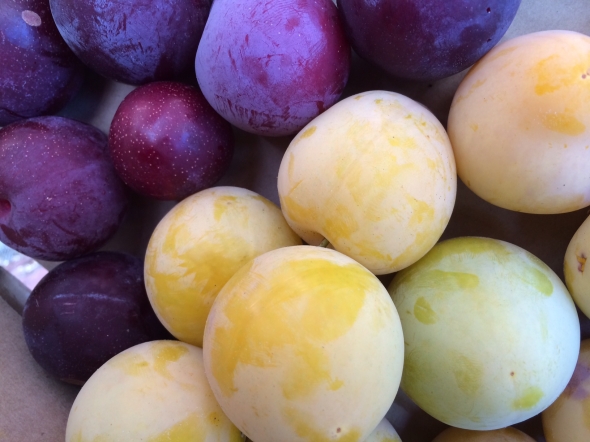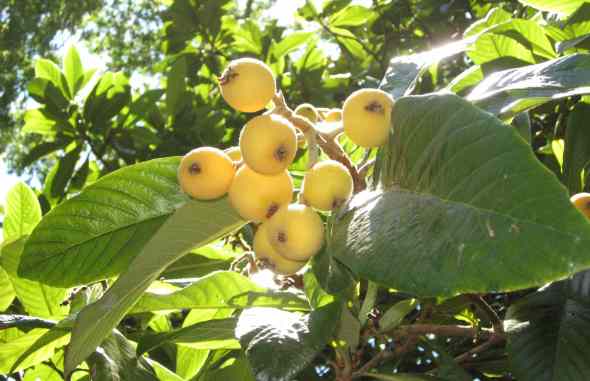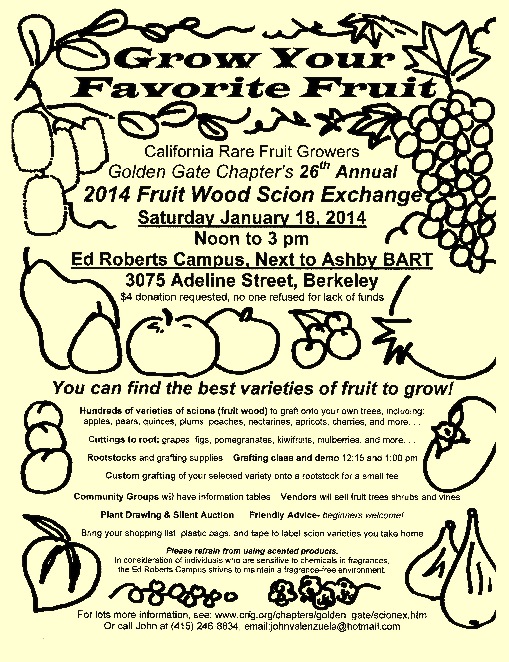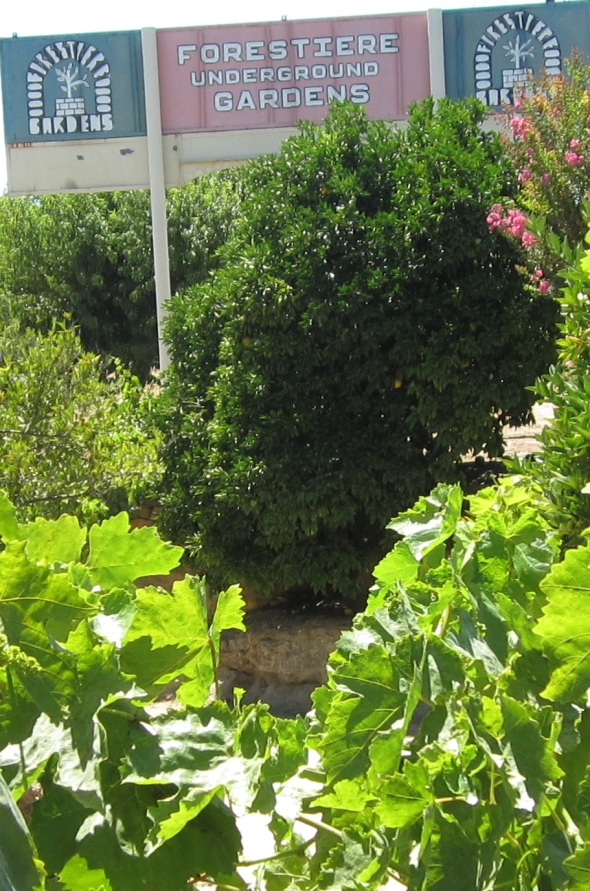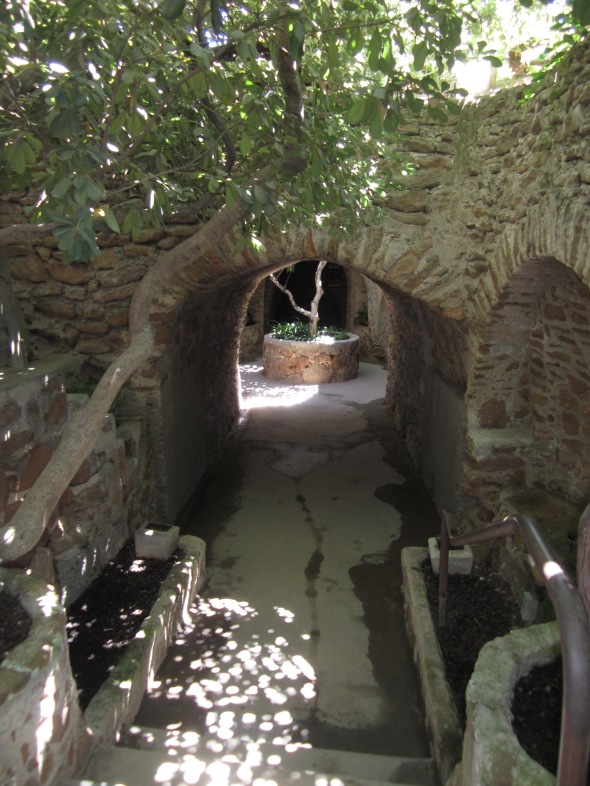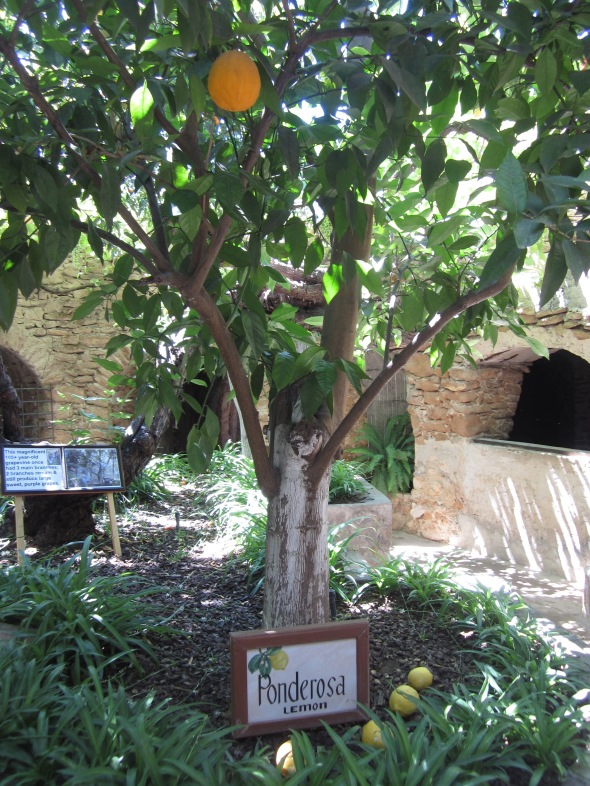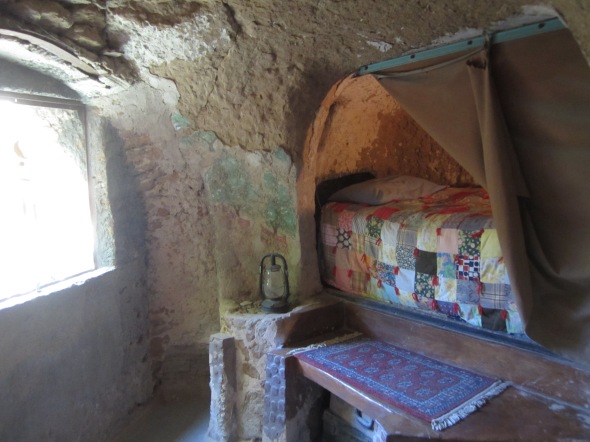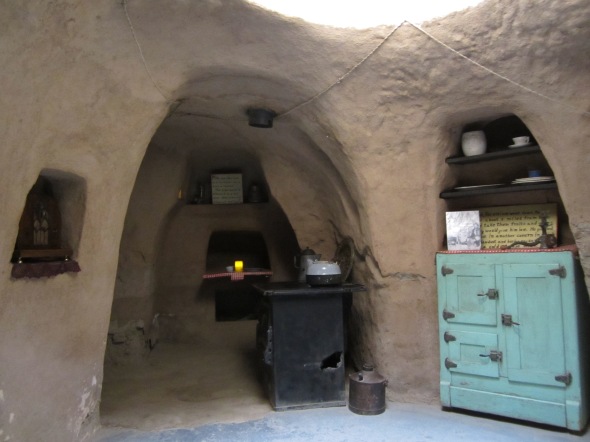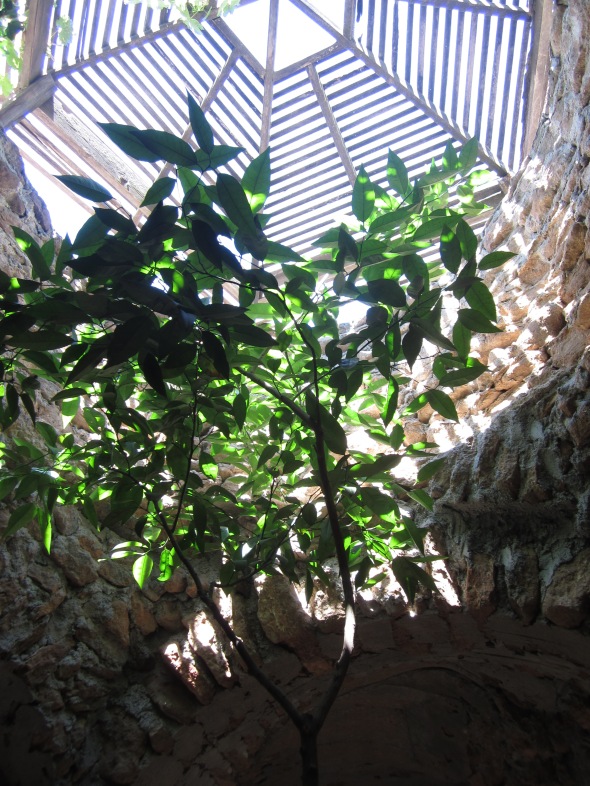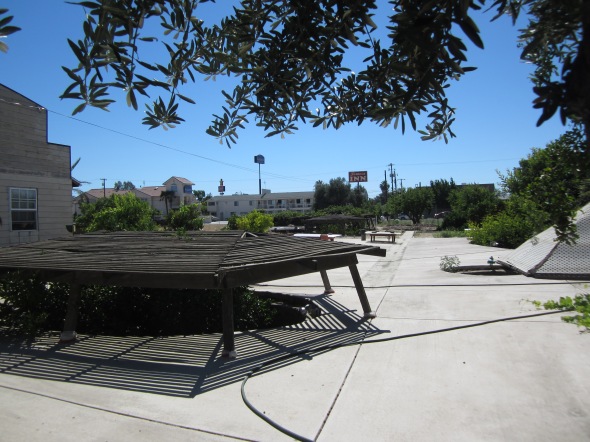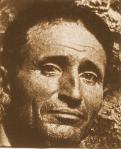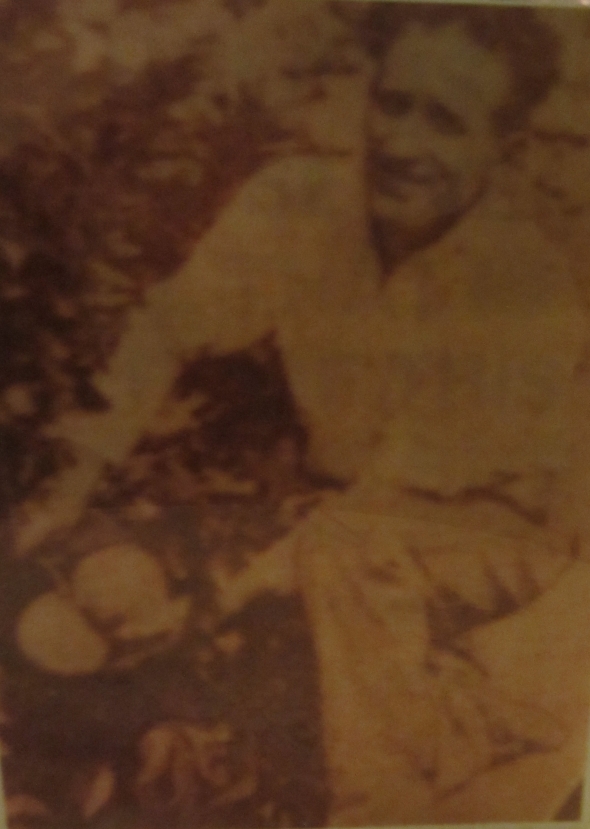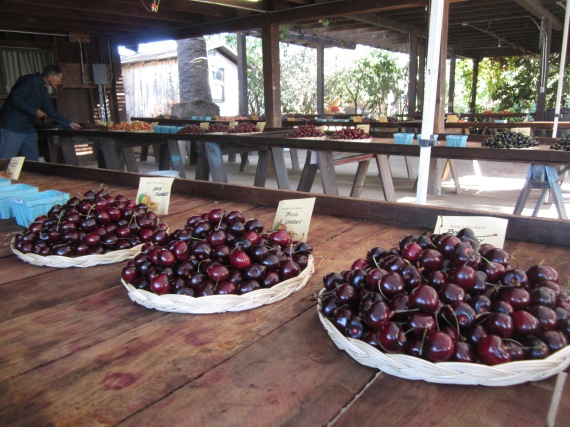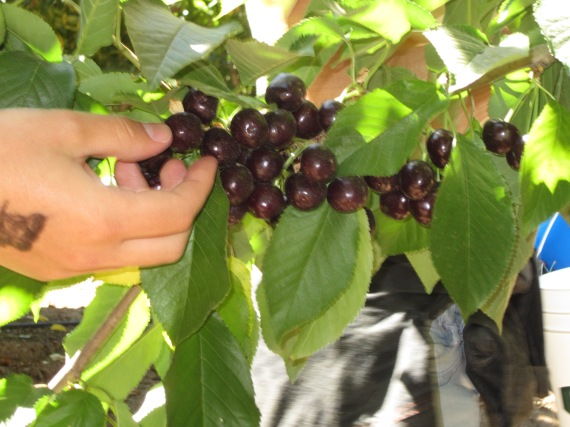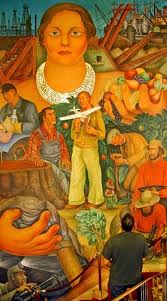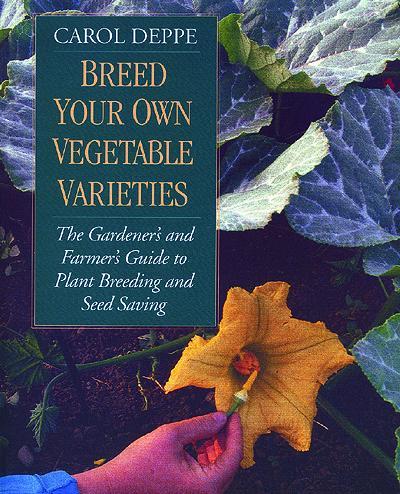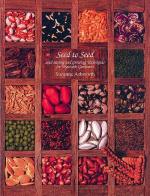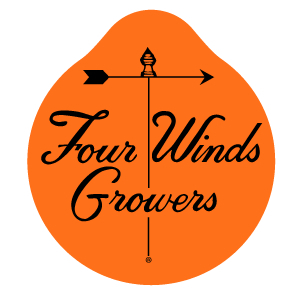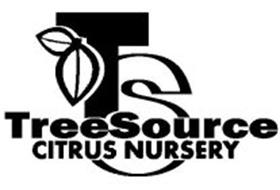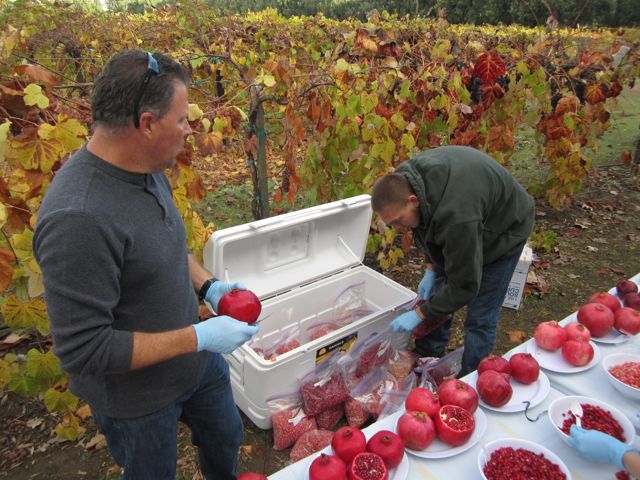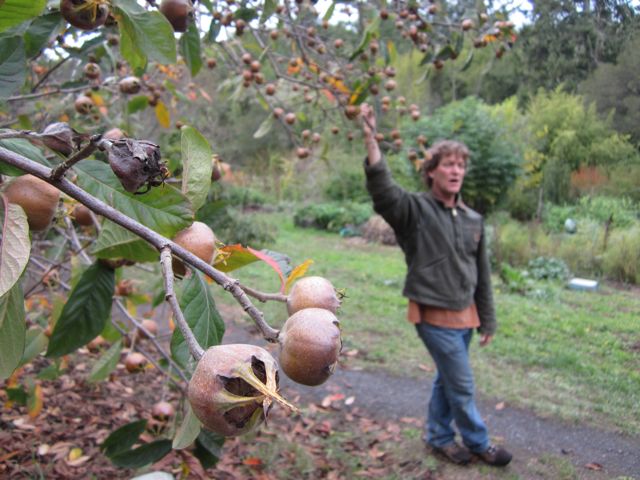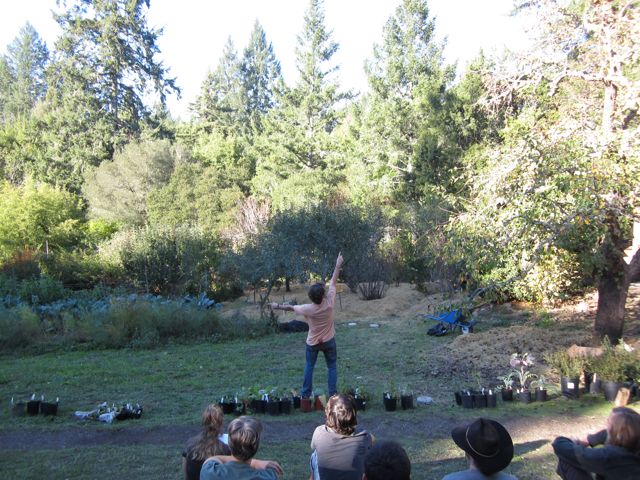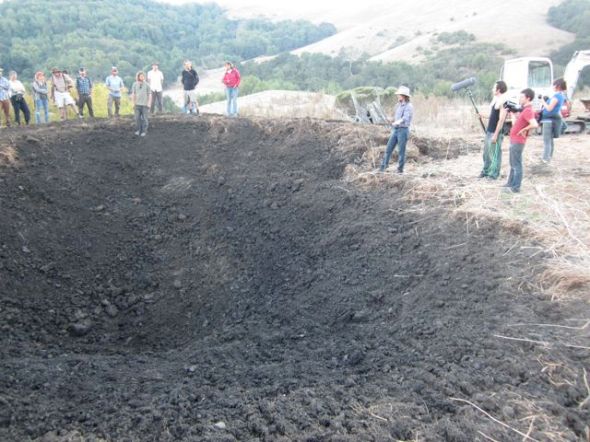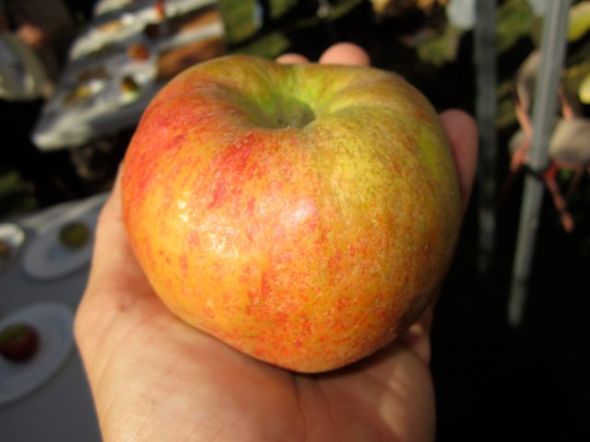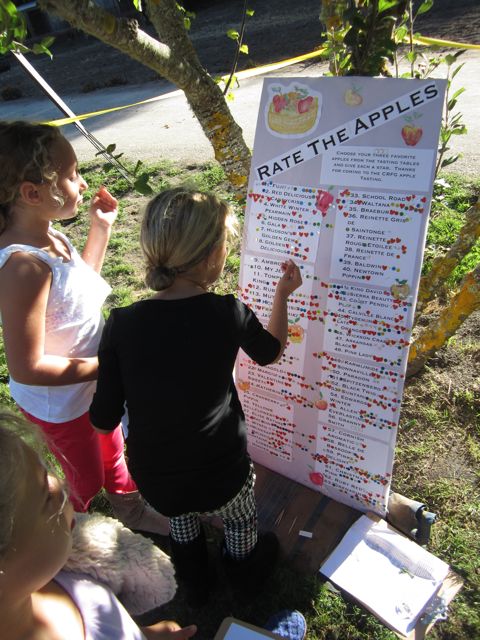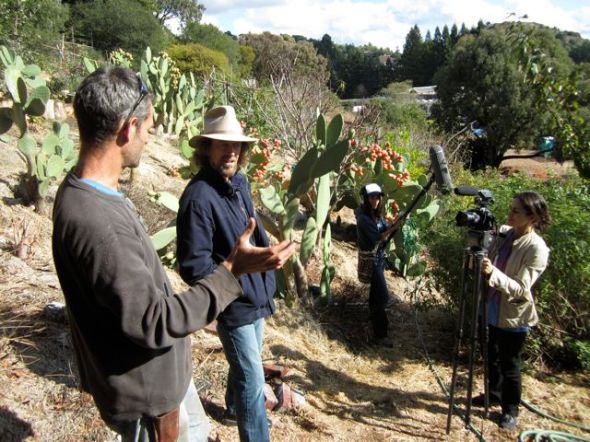Bill Mollison 1928-2016
Bigger than life…biogeographer, story teller, inspiration for sustainable design practice. From the backyard to the “Global” gardener.
Bill wasn’t perfect (who is?), but we loved him, and the worms will too.
Summer Fruit Season is Here!
Well it has been quite a while since my last blog post here, but I hope you have been following my twitter feed (last few tweets over there in the right column).
Summer fruit update:
Problems
Continued dry and warm winter weather had it’s effect on the health of fruit trees. Two very dry winters meant that there was no residual ground waterr stored in the soil. Being used to typical wet winters, many back yard growers did not irrigate enough and the trees are suffering. Please water your trees! Especially young trees need good watering. We are suffering in this drought, so do recycle graywater, and build yourself some rainwater catchment.
Adding to our problems was the approximate 50% of normal “chill” hours or units, affecting certain northern species like cherries, apples, aronia, haskap/honey berry, among others. Chill hours are calculated in several ways, but it is generally: total accumulated hours of temperatures between 45F and 32F, between November and February.
Typical symptoms were obvious with my ‘Honeycrisp’ apple this spring: delayed and ongoing flowering (currently holding normal size half grown fruit, smaller marble size fruit, and flower buds just opening), delayed leafing out, with many branch tips bare, and new growth from lower branches. This is a great time to see which trees are actually low chill, and to consider increasing plantings of them.
The few rains we did have were timed perfectly to promote heavy fireblight damage. This bacteria thrives in warm wet weather in the spring, especially during flowering, with bees actually spreading the pathogen from tree to tree. I have had major losses of large, otherwise health pear trees, including ‘Bosc’, ‘Williams’/’Bartlett’, and asian pears. Fortunately my favorite pear, ‘Seckle’ is fairly resistant, and has been used in breeding of other resistant varieties, like ‘Magness’ (‘Comice’ X ‘Seckle’). Without many options to prevent, or cure, the only thing I can reccomended is to prune out damaged branches back to healthy wood/cambium, and planting resistance varieties.
Maggots in yor fruits? Cherry Fruit Fly and Olive Fly
I am getting used to maggots in my ripe berries, but was sad to find them I am early whit nectarine this year. Cherry Fruit Fly, or Spotted Wing Drosophila (SWD) attracts whole fruit not just rotten fruit, like most fruit flies. I will put out apple cider bottle traps for SWD and for the Olive fly. With many wild untreated olive trees in our area, this fly causes about 90% crop damage most years. Trapping can reduce damage significantly, but commercial growers use a baited Spinosad product called “GF-120”. It is approved for use by organic growers, but is not so available to home gardeners. Instead I have been spraying a kaolin clay “protectorant” product called “Surround WP” (wettable powder). This can make egg laying difficult for olive flies, and coddling moth on apples. All my olive and apple trees are very white this time of the year! I will re-apply every 6 weeks until harvest, and will need thorough washing after.
To much of a good thing: Thin, thin, thin that fruit!
The dry spring weather made for an immense fruit set on many stone fruit and apple varieties. If you are greedy, and try to let all those fruit to mature you could have some serious problems: Breaking branches, (can be moderated by use of props, bands and straps), severe “alternate bearing” causing the tree to overbear one year and resting by producing no fruit the next, disease and pests are made worse with crowded fruit branches, quality of fruit is also compromised when crowded, with less sugar, less color and smaller. Please do not hesitate to take off all the excess fruit. Imagine a full size fruit on the branch, and allow room so the fruit won’t touch– about 4 to 8 inches apart.
Summer Pruning and Grafting
This season’s branch growth is becoming more woody now (hardening off) and now is a great time to do some summer pruning to control growth from the buds we left behind from our winter pruning. The bottom of this seasons growth is perfect for various summer budding and grafting techniques. We graft year ’round!
Summer Fruit Tastings Begin!
Andy’s Orchard had the first fruit tasting of the 2015 season. Held on Father’s Day, I attended with my son Ijah. Andy announced to a crowd of a couple hundred attendees that “this is our worst fruit harvest year ever”, with cherries having a 95% crop loss, mostly due to lack of chill hours. Though we did not taste as many as the 55 varieties as I had in the past, there were still many dozens of varieties of stone fruit to enjoy–including a dozen kinds of cherries and many apricots, plums, inter specific hybrids, peaches and nectarines. Find the schedule for the rest of the summer tastings at Andy’s Orchard website.
http://andysorchard.com/cart/index.php?_a=viewDoc&page=orchard
Keep it Juicy!
JV
INTERdependence Celebration – Collective Gardening, Tour and Fruit Tasting, BBQ/Potluck and Pool Party

Sunday, July 6
9am – 5pm
https://www.facebook.com/events/1627584290800387*** RSVP REQUIRED ***
Please RSVP to Gustavo@swirlspace.com to reserve a spot and we will send address & more information$10-20 Donation sliding scale + Potluck item
Use Paypal Donation below or bring cash
https://www.paypal.com/cgi-bin/webscr?cmd=_s-xclick&hosted_button_id=7DVPEHK7K2WR6
——————————————————-
https://www.facebook.com/events/557318967710617/
Join our Facebook Group for updates:
https://www.facebook.com/groups/1622702131288665/
TENTATIVE SCHEDULE FOR THE DAY
——————————-
MORNING HANDS IN THE DIRT (9am – 12pm)
We will work in the veggie gardens to clear, weed, plant, transplant, propagate, harvest and learn together.
POTLUCK & POOL PARTY (12pm-5pm)
Get refreshed in the large swimming pool and share some food amid the palm trees & roses. Bring your swimsuit and a dish/drink to share… Musical instruments & Merriment welcome!
GARDEN TOUR & FRUIT TASTINGS (1pm-2pm)
The 5 acre property includes native oak forest and chaparral, 100-year old buildings, fruit trees and vegetable gardens, bamboo grove, fragrant rose collection and nursery. With established fruit trees that have been multigrafted, there are now about 150 varieties of fruit growing.
Fruit tastings: Raspberries, Plums, Citrus.
AFTERNOON WORK SESSION (2pm-5pm)
For those of you who cant make it in the morning but would like to play in the garden. Work and cool off in the pool anytime.
HOSTED BY:
John Valenzuela, Permie “Fruit Freak”
Gustavo Alcantar, Swirlspace EcoDesign
The tour and garden activities will be lead by John Valenzuela, gardener, consultant and Permaculture educator, who is also known as an expert ‘fruit freak’, serving as chairperson for the Golden Gate chapter of the California Rare Fruit Growers. John has been maintaining this land for several years, and is pleased to announce that there will now be opportunities to share the garden space for collaborative food growing. John’s gardening, consulting and education services are offered as Cornucopia Food Forest Gardens, with lots of information at http://cornucopiafoodforest.com/
Solstice at GEM- Gardening , Talk and Tour of Orchard and Gardens, Fruit Tasting, Pool and Potluck
Please join us at the second of our summer series at the Garden of Eve ‘n’ More (GEM)
on Saturday Jun 21, 9am to 5pm
Our first event was great, and we were greatful for the pool when it got to 100 F that day!
More info and details at the events page: https://cornucopiafoodforest.wordpress.com/upcoming-events/
and facebook: https://www.facebook.com/events/557318967710617/
*** RSVP REQUIRED ***
$10-20 Donation sliding scale + Potluck item
Please RSVP to gustavo@swirlspace.com to reserve a spot and we will send address & more information
Tour, Gardening, Potluck and Pool Party near Novato
Interested in collective gardening and orcharding?
Join us this Sunday, the first in a Summer series !
Tour, Gardening,
Potluck & Pool Party
at G.E.M.
——————————————————
Sunday, June 8, 10am-5pm
@ Garden of Eve-n-More, (G.E.M.)
near Novato, CA (address sent upon RSVP)
Hosted by John Valenzuela & Gustavo Alcantar
——————————————————-
Come join us for a day of education and work in the gardens and orchard followed by fun at the pool and a potluck. This is the first event in our summer series.
GARDEN TOUR & INTRO (10am-11am)
We will start with a tour of the 5 acre property, which is a ‘gem’ that includes native oak forest and chaparral, 100-year old buildings, fruit trees and vegetable gardens, bamboo grove, fragrant rose collection and nursery. With established fruit trees that have been multigrafted, there are now about 150 varieties of fruit growing (there may be some berries to sample).
HANDS IN THE DIRT (11am – 1pm)
We will work in the veggie gardens to clear, weed, plant, transplant, propagate, harvest and learn together.
POTLUCK & POOL PARTY (1pm-5pm)
We can then get refreshed in the large swimming pool and share some food amid the palm trees & roses. Bring your swimsuit and a dish/drink to share.
The tour and garden activities will be lead by John Valenzuela, gardener, consultant and Permaculture educator, who is also known as an expert ‘fruit freak’, serving as chairperson for the Golden Gate chapter of the California Rare Fruit Growers.
John has been maintaining this land for several years, and is pleased to announce that there will now be opportunities to share the garden space for collaborative food growing. https://cornucopiafoodforest.wordpress.com/
*** RSVP REQUIRED ***
$10-20 Donation sliding scale + Potluck item
Please RSVP to gustavo@swirlspace.com to reserve a spot and we will send address & more information
https://m.facebook.com/events/251852681673152
————————————————
Choosing the Best Fruit Tree Varieties– getting ready for Scion Exchanges and Bareroot Trees
Get ready for the Golden Gate CRFG Fruit Wood Scion Exchange this Saturday by attending this talk tonight!
Wednesday, January 15, 6:30-8:00PM
This event was a great success! Please scroll down to read the rest of this blog post–
Choosing the Best Fruit Tree Varieties: Preparing for Bareroot Season and Scion Exchanges
with John Valenzuela
At ‘Pollinate Farm and Garden’ in Fruitvale, Oakland
Sliding scale $10-25; no one turned away for lack of funds
register here: http://www.brownpapertickets.com/event/556133
Get ready for this season of bare root fruit trees, and more fruit wood scion exchanges, by getting your fruit tree ‘shopping list’ together for this season. I hope you were taking notes at all those fruit tastings I announced this last summer! In addition to taste, I will also share other considerations about various fruit varieties, including adaptability to various climates, pollination needs, seasonality of harvest, uses in processing, historical considerations, and more. Pollinate Farm and Garden is a great new urban farm supply store that is hosting a great series of workshops. My talk will be the first of this year! Check them out: http://pollinatefarm.com/event/
Later in the season I will also lead a grafting class at Pollinate, so stay tuned!

Pollinate Farm & Garden
2727 Fruitvale Avenue
Oakland, CA 94601
Phone: 510.686 DIY FOOD (3493)
Hours:
Wed – Sat 10:00-6:00
Sun Noon-5:00
2014 CRFG Scion Exchanges in full swing-
While it may be so dry we are needing to irrigate, there are some things that assure us that it is indeed winter. The scions have been cut from the California Rare Fruit Growers scion orchards of favored heritage varieties carefully maintained to preserve hundreds of unique varieties. This diversity of fruit varieties come from many regions from around the world, North America, in addition to local varieties from California, and even right here in the S.F. Bay Area. Even some modern varieties found in supermarkets might also be considered ‘rare’ fruits. Unless you have picked tree ripened plum or peach from your own backyard tree grown in healthy soil, you may never have really tasted these ‘common’ varieties at their prime of maturity and ripeness.
What is a ‘scion’?
Scions are the tips of fruit tree branches used for making new trees, just the same as the original. This vegetative or asexual fruit tree propagation is done by rooting these cuttings, or if that is too difficult, by grafting – joining the scion to a rootstock of a compatible tree. Seedlings may be good for genetic diversity and discovering new varieties, but some species only make one out of a thousand trees worth eating fruit from. If you want a fruit tree that is exactly what you know you like, and that will come into bearing sooner than a seedling, vegetative propagation is the way to go. Come to our big Fruit Wood Scion Exchange this Saturday to learn more, and gain access to hundreds of varieties that are grown by the California Rare Fruit Growers in the Bay Area. The Santa Clara Valley Chapter and Monterey Chapters have already held their exchanges this year, and the Golden Gate chapter is next!
http://www.crfg.org/chapters/golden_gate/scionex.htm
check out the video page too: http://www.crfg.org/chapters/golden_gate/scionex_videos.htm
More scion exchanges in Northern California here:
http://www.crfg.org/chapters/golden_gate/other_2014_scion_exchanges.html
Protect the rights of fruit tree breeders!
A reminder: We do not allow any patented varieties at out scion exchange events.
Some patented varieties of fruit you may recognize are: ‘Zestar’ Apple, ‘Pinova’ Apple, ‘Skeena’ Cherry, ‘Minnie Royal’ Cherry, ‘Royal Lee’ Cherry, ‘Sequoia’ Fig, ‘Jupiter’ Seedless Grape, ‘Neptune’ Seedless Grape, ‘Cotton-N-Candy’ Interspecific, ‘Emarald Beaut’ Plum, ‘UFO’ White Peach, ‘Harrow Sweet’ Pear, ‘Angel Red’ Pomegranate, and about 1,600 more varieties.
Luther Burbank died with limited financial benefit from all the varieties he bred because he did not enjoy the protection of plant patents. Though he supported the protections plant patents would provide, it was just a few years after he died did the Federal Plant Variety Patent Legislation get passed into law.
The following is quoted from the US Patent and Trademark Office (USPTO):
http://www.uspto.gov/web/offices/pac/plant/#1
“What is a plant patent?
A plant patent is granted by the Government to an inventor (or the inventor’s heirs or assigns) who has invented or discovered and asexually reproduced a distinct and new variety of plant, other than a tuber propagated plant or a plant found in an uncultivated state. The grant, which lasts for 20 years from the date of filing the application, protects the inventor’s right to exclude others from asexually reproducing, selling, or using the plant so reproduced. This protection is limited to a plant in its ordinary meaning:”
All the patented plant varieties can be found on the USPTO website search engine:
http://patft.uspto.gov/netahtml/PTO/search-bool.html
A spreadsheet with all patented varieties as of Jan 2012 is found here, thanks to Jason Sutor: https://spreadsheets.google.com/pub?key=0AqoBKzfSt0AudHRmZmk2LWVqUHNrMjJwS29fYWpGenc&hl=en&output=html
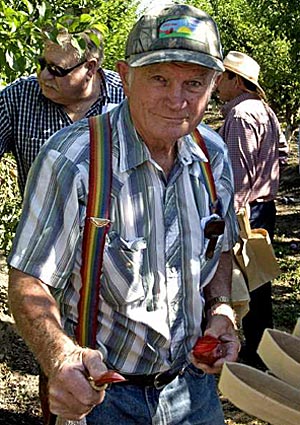
Let’s respect and reward fruit breeders work!.
Floyd Zaiger was Trained by Nectarine Breeder Fred Anderson, who was trained by Luther Burbank
We respect the rights of the breeders who hold these patents. Plant patents do not last forever. They do eventually expire, 20 years from the filing of the patent application. They are then in the public domain, and are free to share. Thanks to the hard work of fruit breeders from Zaiger Genetics, University of Minnesota, Armstrong Nursery, and many, many others; we may consider these great modern varieties ‘future heirloom’ fruits.
Some varieties with expired patents are:
‘Red Baron’ Peach,
‘Champagne’ White Peach,
‘August Glo’ Nectarine,
‘Arctic Snow’ White Nectarine,
‘Arctic Queen’ White Nectarine,
‘Flavor Supreme’ (PlumXPlum Cot),
‘Flavor Queen’ (PlumXPlum Cot),
‘Flavor King’ (PlumXPlum Cot)
‘Janice’ Fig
‘Ginger Gold’ Apple,
‘Honeycrisp’ Apple,
‘Cameo’ Apple
‘Enterprise’ Apple
‘Goldrush’ Apple
‘Cripps- Two’ Apple aka Sundowner®
‘Cripps Pink’ Apple (which also has another trademarked brand name: Pink Lady®)
Trademarked names are a separate issue. Trademarks are brand names used for certain varieties, with the mark ® if federally registered (renewable every 10 years), or with the ™ if the trademarked is just claimed.
For more on trademarks and patents see this article, from Oregon State: http://extension.oregonstate.edu/gardening/what-does-it-mean-when-nursery-plants-are-patented-or-trademarked From a couple of nurseries, more on the confusion multiple names for varieties causes: short article- http://www.lazyssfarm.com/Inquiring%20Minds/trademarked_plants.htm , and a longer article-
http://www.plantdelights.com/Article-Trademarks-in-Horticulture
Collect scions while you prune your fruit trees.
For some tips on how to prepare scions to bring to the exchange see some of our videos on preparing for the exchange, here:
http://www.crfg.org/chapters/golden_gate/scionex_videos.htm
Pruning classes abound in the Bay Area: at Berkely Hort. Nursery, Berkeley Youth Alternatives, the Institute of Urban Homesteading, and other venues.
Please consider joining me at the Berkeley Eco-House backyard food forest for a pruning class, Sunday, Feb. 2nd. More info here:
http://ecologycenter.org/events/winter-fruit-tree-pruning-theory-demonstration-and-hands-on-practice/
One more class to mention:
The Marin Master Gardeners will host me presenting the talk: “Fruit Tree Diseases and Pests in the Home Orchard”. The program is February 26, 2014, 12pm-1pm at the Boro/Pickleweed Community Center in San Rafael. Hope to see you there-
Please let me know if you need advice regarding your fruit trees, or need any pruning or grafting this season.
See you at the exchanges! Or maybe at that cherimoya tasting in So Cal.
JV
The Magic of the Forestiere Undergound Gardens: a sustainable underground oasis still fruitful after 100 years
The Visionary Underground Gardens of Baldassare Forestiere
(all rights to images belong to the Forestiere Underground Gardens)

Baldassare Forestiere and his inspired life’s work- vision of an oasis shaped in stone work and filled with fruit trees, including many multi-graft citrus
While on my way to attend the Organic Stone Fruit Jubilee in Clovis, held days after the summer solstice, I just had to make a pilgrimage to a place I have been dreaming of for many years: the famed underground gardens of Baldassare Forestiere (1879- 1946). These unique and other-worldly gardens are still maintained by the Forestiere family, and are seasonally open to offer tours to the public, which I highly recommend. Much of the following stories I recall from those told by our excellent tour guide, Lisa. Any errors are my own http://forestiere-historicalcenter.com/
I drove from the 54 degree foggy coast of Santa Cruz to the 93 degree early summer Central Valley heat of Fresno, which can be regularly over 100 degrees later in July and August. It was this extreme heat that Forestiere sought to escape in his underground caverns, creating an productive oasis of citrus and many other fruit trees that grow throughout his artistic home in a never ending expression of his visions of paradise.
Immigrating from Sicily as a 22 year old unschooled and self taught skilled laborer, he left is homeland after a bitter argument with his father to seek opportunities in America to start his own citrus empire. First living in Boston and New York, he labored digging in the new subway tunnels. The unfriendly winter climate frustrated his dream to grow citrus, so he left the North East to search for suitable terrain in the famed subtropical fruitlands of Southern California, only to be thwarted by the exorbitant land prices. He heard rumors of less expensive land to the North, in the Central Valley farming town of Fresno, where he arranged to purchase 80 acres, sight unseen in 1906.
To his dismay, he discovered his new property was underlain with a shallow hardpan of cement like sedimentary rock, making planting trees near impossible. In addition the searing summer heat was especially brutal that year. Seeking to escape the heat, he excavated an underground shelter, breaking through the hard pan, and using the rock as bricks. He knew such a shelter would be cool in the summer and warm in the winter, as the earth has an average 55 degree temp year around, at a 20 foot depth. By day, he was employed as a ditch digger in the area, as he developed his property in his ‘spare time’, by himself. Never using dynamite, as he feared the damage of work already completed, he worked endlessly with only his hand tools, and his two mules, for some 40 years, until his death in 1946.
His creation was no dark, dank cave- Throughout the endless maze-like tunnels there are hundreds of wonderful ‘Roman’ stone arches, full of light and cool fresh air, amid an abundance of fruit hanging from the living trees!
Fulfilling his dream, Forestiere found that he could cultivate his beloved citrus and other fruit trees in rock walled planters under the many skylights, protected from winter frost and summer sun with lath structures, the roots remained cool in the summer and warm in the winter.
Inspired by his Roman Catholic faith, he created many plantings with patterns of threes and sevens, representing the Holy Trinity, and the Seven Sacraments. Without any written plans, he worked from his mind’s eye, eventually manifesting some 55 rooms, atriums, and grottos, including a chapel, 2 bed rooms, dining room, kitchen, fish ponds, ball room, extensive car port and more, wandering under more than 10 acres of land. Not only beautifully inspired, it is functional vernacular: with a water well, rain water catchment and drainage systems, solar heated bath, wood heating kept the small rooms cozy and the earth kept it cooled. Hundreds of ‘Roman arches’ support the ceilings, while the natural airflow is directed to keep a cool breeze circulating. Many passage ways and rooms align to allow views across hundreds of feet underground, while some secret observation holes were used to watch for the possibility of intruders, inspired by the famed secret catacombs of the old country.
After completing an adequate home for himself, he continued with his labors, with his ultimate plan to create an underground oasis resort for visitors to escape the summer heat, and to share in the enjoyment of the abundant fruits of his gardens. He never opened the resort, having worked for some 40 years on his ever expanding visions, is was never quite ready for the public. Though needing constant care and maintenance, the stonework stands strong, and the fruit gardens live on, including many species of fruit trees, now still bearing, after more than 100 years .
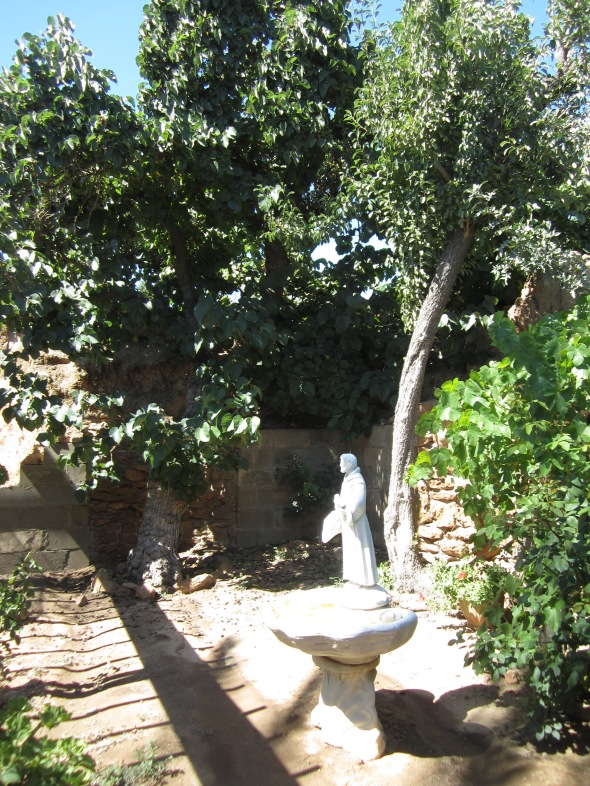
St Francis watches over the still productive fruit trees and vines, of mulberry, grape, citrus, pear, roses and more-
A partial list of plants I saw at the Forestiere Underground Gardens:
Olive
Pomegranates
Loquat
Carob
Jujube
Pear
Quince
Fig
Date
Black Mulberry
Grapes,
according to their website, http://www.undergroundgardens.com/amazingfacts.html
Grape varieties included ‘Alicante’, ‘Thompson’,
‘Muscat’, ‘Grenache’, ‘Black Morocco’, and ‘Zinfandel’.
Another unique skill applied to his vision was the many multigrafted citrus trees, still found found flourishing and full of fruit today.
Citrus multi-grafts:
Orange sweet and sour types
Lemon sweet and sour types
Grapefruit
Kumquat
Cedro or Citron
You can learn how to graft citrus too!
I have done several grafts onto one citrus tree, but Mr Joe Real of Sacramento, has a tree of more than 100 varieties on one tree! Yes, that would be lot to manage, but it is possible. If you are at a more ‘beginner’ level of wanting to learn how to graft a single variety, trying your hand at this ancient art of ‘making two grow as one’, please join us this weekend.
Grafting citrus is something that is done in these summer months, so you are invited to a workshop to learn how to make your own single variety citrus tree this Saturday, Jun 29. Out at the Indian Valley Organic Farm in Novato, Marin Co., fruit trees we have grafted at prior grafting workshops have been planted, cared for, and now are bearing their first fruits. At this workshop, we will have over 20 varieties of disease and pest free citrus grafting buds to choose from, and we will help you graft a tree to take home. For more information on specific varieties and registration see:
https://cornucopiafoodforest.files.wordpress.com/2011/02/citrus-grafting-workshop-flyer-6-29-131.pdf
This summer, when Fresno is sweltering in typical 100 degree plus heat, take the time to retreat into the lush and productive subterranean oasis that is the Forestiere Underground Gardens. A truly unique and inspirational food forest!
High Speed Rail Development Threatens the Gardens
Whether you visit to take a tour or not, please let them know you are opposed to any disturbance to the gardens and access to their educational tours during the proposed high-speed rail development construction adjacent to the gardens.
http://www.undergroundgardens.com/delistingalert.html
Happy Solstice! Summer Fruit Tasting Season Has Begun-
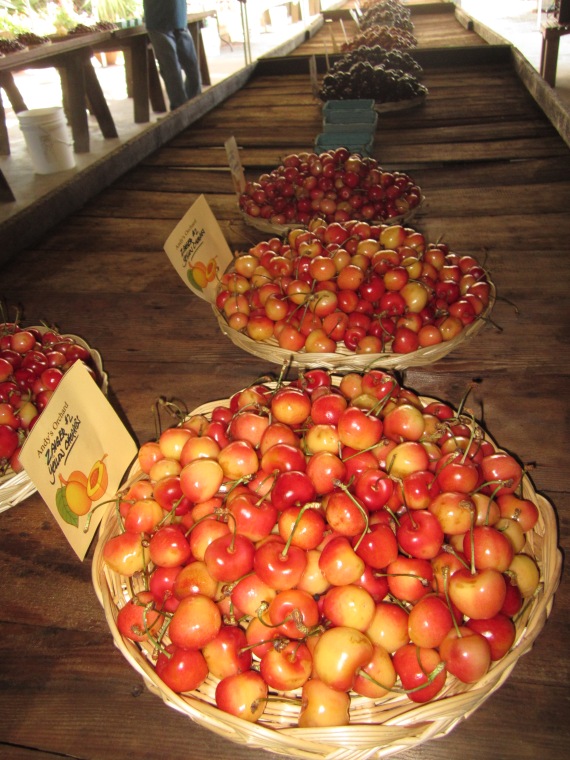
This tasting featured cherry varieties from centuries ago in Europe, old American favorties, and brand new varieties bred by Zaiger Genetics, and others by the Santa Clara Valley CRFG Hybridizers Group.
The longest day of the year is here and the fruits are falling from the trees. Will you be there to taste test the delicious diversity? Well there are many opportunities to expand your palate.
I have a whole page dedicated to listing the upcoming fruit tastings I know of in the Northern California area:
https://cornucopiafoodforest.wordpress.com/upcoming-events/fruit-tastings/
please send me any tastings I have missed!
I started this year’s summer fruit tasting season with my son on Fathers Day last Sunday at Andy’s Orchard in Morgan Hill, South of San Jose.
I have been to as many of these tastings at Andy Marinani’s farm as I can get to. Andy is renowned for having the top collection of stone fruit varieties commercially available purchase by the public. He generously contributes propagation material from many varieties of stone fruit and persimmon which are offered at the California Rare Fruit Growers annual scion exchanges, and leads the Santa Clara Valley Chapter CRFG Hybridizers Group. Don’t feel bad you missed this first tasting, as he holds several during the summer stone fruit season. His website with details of future tastings is here:
http://andysorchard.com/cart/index.php?_a=viewDoc&page=orchard
This year Sunset magazine’s June 2013 issue just came out with an eye popping article on Andy Mariani and Andy’s Orchard, of course mentioning their seasonal fruit tastings. This publicity lured the crowds of tasters to number an estimated 300+.
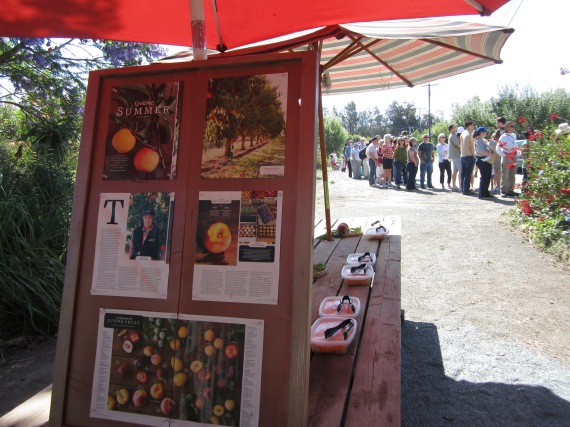
Sunset magazine feature article about Andy’s fruit gave people reason to wait in such long lines to enter.
Our bellies were getting full and our taste buds saturated, having tasted 34 varieties of cherries, and a dozen other early stone fruit varieties, topped off with a chocolate dipped fresh cherry! Then there was the orchard harvest walk, this time with the alert leadership of Karl Gross, scion exchange co-ordinator for the Santa Clara Valley CRFG. We took home some rare fruits: including a few pounds of the ‘Black Republican’ cherry, mother of the renowned ‘Bing’.
This weekend there are at least two tastings on the same day, scheduled so that you could actually attend both.
At 10 am on Saturday, June 22, the USDA National Clonal Germplasm Repository will host a mulberry and early stone fruit tasting at the Wolfskill Experimental Farm near Winters.
This is a historic site, founded before the gold rush, by John Wolfskill. It now is managed by the University of California, with a section containing the USDA fruit nut and vines collections. They also host multiple tastings throughout the seasons. Lead researcher John Preece and his field managers and researchers maintain thousands of varieties in their collection and are very knowledgeable, and glad to share information at these tastings. Their website is full of information on the collection:
http://www.ars.usda.gov/main/site_main.htm?modecode=53-06-20-00
Later in the day on Saturday at 400pm, another fantastic event will be held in the Central Valley:
The Organic Stone Fruit Jubilee, held at the Mokichi Okada Association’s Oasis Garden in Clovis. Nearly a dozen organic orchardists will be sharing over 60 varieties of fruit starting at 5pm. More information here:
http://www.eco-farm.org/programs/heartland_project/organic_stone_fruit_jubilee/
The more fruit you taste, the better your reference points are to know what you like and describe for others what they might like too. This will allow you to make a better shopping list for our winter scion exchanges. It is hard to remember those warms summer fruits in the cold of January, so make good notes! Your taste buds just might start to tingle when you hear those special names again.
Keep it juicy!
JV
Hayes Valley Farm is ‘branching out’ in it’s transition, take some of it home
In my last post, I mistakenly announced the Final Farm Fiesta was on Saturday, but it was held on Sunday. Hayes Valley Farm was from the beginning planned as an interim use of abandoned freeway off-ramp land that eventually would be built upon when the economy picked up. For three years the farm has grown literally tons of food, through touching and been touched by thousands of urban SF gardeners. Inspiring!
Get a piece of this at their plant sale this weekend Sun May 12: https://www.facebook.com/media/set/?set=a.10151582075368069.1073741827.273374513068&type=3&l=230c98082b
Here are some related links:
HVF facebook page: https://www.facebook.com/hayesvalleyfarm
HVF twitter:https://twitter.com/hayesvalleyfarm
Many photos posted of the Final Fiesta: https://www.facebook.com/media/set/?set=a.10151584009303069.1073741828.273374513068&type=3&l=dfffbe10f5
A great local radio show, ‘Chew on This’ on KALW, had a great first episode that included a story on the movement around the transition of the Hayes Valley Farm: https://soundcloud.com/chewonthisradio/chew-on-this-season-1-episode
The Bay offers so many plant sales this weekend!
From Occidental Arts and Ecology Center’s rural location to Merritt College Hort Dept in the Oakland hills to the People’s Grocery in the Oakland flatlands, to the largest- at San Francisco Botanical Garden, lots of really great plant sales!
On a sad note, the Hayes Valley Farm will have it’s Farm Farewell Festival “Branching Out” this Saturday too.
see all the details on the events page here:
Happy Birthday John Muir, naturalist and orchardist
Many people have heard of John Muir’s long walks through out the United States and California, and his founding of the Sierra Club. But many do not know that Muir managed a very large, mixed fruit orchard for more than a decade, originally planted by his father in law, in the Martinez area of Northern California.
But he did not discover the ‘Muir’ peach!
The original fruit orchards were first established in
1853 by prominent physician and horticulturist Dr.
John Strentzel, a Polish immigrant settling in the
Alhambra Valley to farm, as California gold rush
opportunities waned. When naturalist and
conservationist John Muir married Dr. Strentzel’s
daughter, pianist Louisa Strentzel in 1880, the
ranch was at its peak, with 2,300 acres growing a
collection of over 1,000 varieties of fruits and
ornamentals.
Strenzel Ranch Orchards, established 1853, Martinez, California
John Muir became ranch manager at that time, as
Dr. Strentzel’s health declined. Muir began to make
the ranch more efficient by reducing the number of
varieties by top-working the trees to those that
were economically feasible to produce, and sell
across the US with the nearby railroad access.
When John Muir’s brother David took
over management in 1892, it freed John to
continue his explorations and conservation work,
that year founding the Sierra Club.
John Muir died in 1914, and is laid to rest on the ranch property.
The National Park Service now manages 336 acres of the original ranch which includes the orchards, the Victorian era ‘Muir House’, the original ‘Martinez Adobe’, and grave sites of the Strentzel family, with the majority of the acreage including Mt Wanda.
The John Muir National Historic Site website is http://www.nps.gov/jomu/index.htm.
Here is a link to the Orchard Management Plan for John Muir National Historic Site, with more detail on the fruit trees:
http://www.parks.ca.gov/pages/22491/files/sample%20orchard%20management%20plan.pdf
The ‘Muir’ peach is named after John Muir, but not the one you think!
The heirloom peach variety known as ‘Muir’, is a not so pretty freestone peach with firm yellow flesh that was commonly used for drying (I can attest it is also a fine fruit for fresh eating too!). The many seeds made available from such large scale processing were used as a source of seedling rootstock. Now ‘Lovell’, another drying peach originating in the Winters area in 1882, is the most commonly available seedling peach roostock. Also notable is that ‘Muir’ has shown to be one of the few peaches resistant to ‘peach leaf curl’ (Taphrina deformans), the very common and bothersome fungal disease.
The origin: The ‘Muir’ peach was discovered in 1880 by John Muir, but he was another, different man named ‘John Muir’. This different John Muir was a farmer in the ‘Silveyville’ area, now known as Dixon, and was not known to be directly related to the more well known John Muir, the naturalist. According to Wickson in ‘Fruits of California’, ‘Muir’ was named and first propagated by G.W.Thissell of Winters, being discovered on Muir’s property. http://books.google.com/books?id=ZhgDAAAAYAAJ&q=muir#v=snippet&q=muir&f=false Thissell farmed fruit in Pleasant Valley and was an important nurseryman. He also wrote “Crossing the plains in ’49” in 1903, about his first journey to California
http://archive.org/details/crossingplainsin00
The Luther Burbank connection: Burbank used the ‘Muir’ peach in his breeding program, originating ‘Opulent’ white peach in 1901, and the ‘Lemon Muir’ peach in 1913, the latter which was said to be better looking fruit than ‘Muir’. Both of these Burbank bred descendents of ‘Muir’ are claimed by different sources to be ‘Muir’ peach X ‘New White’ nectarine seedlings, and are today very hard to find, if not lost.
‘August Etter’ peach, was bred by apple breeder Albert Etter’s brother, August Etter and it is believed that ‘Muir’ is a parent. ‘August Etter’ peach is also curl resistant, and is offered for sale by Greenmantle Nursery:
http://www.greenmantlenursery.com/fruit/peaches.htm
For more on the details of John Muir tending fruit, the ‘Muir’ peach, and a possible chance meeting of John Muir and Luther Burbank at the Ferry Building in San Francisco (including some heart-felt written correspondence between them), read the excellent and extensively footnoted article:
“Two California Lions, John Muir and Luther Burbank” by Roberta M. McDow in “The John Muir Newsletter”, University of the Pacific, Stockton Ca., Volume 17 No. 1, Winter 2006/2007, available online at http://www.pacific.edu/Documents/school-college/centers/john_muir/Winter2006-07.pdf
Happy Birthday Luther Burbank

Luther Burbank
From the showy ‘Shasta Daisy’, to the succulent ‘Santa Rosa’, ‘Elephant Heart’, ‘Wickson’ and ‘Inca’ plums, and the delicious but overly vigorous ‘Himalaya’ blackberry, to the ubiquitous ‘Russet Burbank’ potato used to make Mc Donald’s French fries, we have literally hundreds of plants to thank Burbank for.
Born in Lancaster Mass. on this day in 1849, he was the 13th of 15 children, and was sensitive child of fragile health. He began gardening when young, and at age 21 he bought 17 acres with his fathers inheritance. In his fields he discovered a rare potato fruit, from which he derived a valuable new potato variety, the ‘Burbank’ potato. The money he earned by selling this new variety allowed him to relocate in Santa Rosa California, where he found the best place in the world to grow plants.
During his long productive life, Burbank introduced some 800 varieties of plants by importation from near (native Californian) and far (China and Japan), crossbreeding, selection, multi-grafting, and distribution. He introduced over 100 varieties of plums alone! His neighbors complained that he was a tree burner, not a tree grower, as only 1 in 10,000 seedlings of his countless cross pollinations might be worthy of naming and promoting, with the other 9,999 to be disposed of in dozens of giant burn piles.
Though during his career he worked with no protection of patents, made some poor business alliances that spoiled his reputation, made exaggerations common in the nursery industry (still today!), and frustrated scientists with his non-scientific methods, he got results that we recognized here in California and even internationally. He was a pomological contemporary of professor Edward J. Wickson of the University of California, editor of the ‘Pacific Rural Press’ which often featured the results of Burbank’s breeding work. Wickson so praised Burbank’s ‘Perfection’ plum, Burbank renamed it ‘Wickson’, still available under that name today.
In another hemisphere, inspired by books describing Burbank’s creations, communist revolutionary I. V. Lennin commissioned Nicolai Vavilov to create the Institute of Breeding and Plant Genetics, and to visit Burbank, leading to the recognition of famed Russian fruit breeder I.V. Michurin.
Some articles and books to better understand the art and industry of Burbank’s life and work:
Crow, James F. Plant Breeding Giants: Burbank, the Artist; Vavilov, the Scientist
includes a great description of Burbank in a obituary by Vavilov.
digitial version: http://www.genetics.org/content/158/4/1391.full

Blood plum of Satsuma (left upper), Burbank plum (right upper) and crossed plums between the Burbank and Satsuma
Burbank, Luther (1915). Luther Burbank: His Methods and Discoveries, Their Practical Application, I-XII vols. Luther Burbank Press.
Illustrated with dozens of color plates, this work of twelve volumes is an extensive compilation of notes and writings on Burbank’s work by various ghost writers and editors, in addition to Burbank himself. Volume V on plums is particularly interesting, a couple of images from that chapter are shown above (stoneless plum??!!!).
complete digital version here:
http://uwdc.library.wisc.edu/collections/HistSciTech/LutherBurbank
Dreyer, Peter. A Gardener Touched with Genius: The Life of Luther Burbank
Published in 1993 by Luther Burbank Home & Gardens
This expanded edition provides the best biography of Burbank in print; it also includes “Another Mode of Species Forming” by Burbank (1909), “The Training of the Human Plant” by Burbank (1906), and “Luther Burbank’s Plant Contributions” by W. L. Howard (1945). 230 pages + appendices, some illustrations. The inclusion of Howard’s work (which took years to compile) is one of the few places you can find this most complete list of Burbank’s plant introductions.
His methods were not always purely scientific method, depending on intuition in addition to observation for many of his selections, and often purposely obscure and secretive to protect his work, but his results were renowned. He was seen by an amazed and enchanted public as the ‘Plant Wizard of Santa Rosa’.
http://archive.org/details/gov.archives.arc.92287
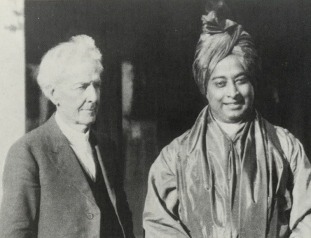
Yogananda referred to Burbank as “beloved friend”.
Burbank’s mother was a Burpee, making him a cousin of famed seedsman W. Altee Burpee. They visited and admired each other’s work. When W. Altee died in 1915, his 22 year old son David took over. Upon Bubank’s death, Burpee inherited most of Burbank’s extensive flower and vegetable collection.

After Burbank’s death, his wife leased the collection at Gold Ridge in Sepastopol to Starks Bros. Nursery of Missouri (founded 1816), who then released the famed ‘July Elberta’ peach and other selections from the extensive test grounds. They actually trademarked the Burbank name to describe his varieties. Though most of the trees were destroyed by Starks Bros. (so as to hide anything good they missed), Elizabeth sold the Goldridge Farm to be used for low-cost elder housing, with the stipulation that a few acres would be preserved as orchard- and so it stands today as a public park in Sebastopol.
http://www.wschsgrf.org/luther-burbank-gold-ridge-experiment-farm
During his lifetime he mentored many workers, and one named Fred Anderson later went on his own to work on breeding fruit, creating the famed ‘Le Grand’ line of nectarine cultivars. A young man worked under Anderson, another generation learning the methods of Burbank, his name was Floyd Zaiger.
Now working with his family business that includes three generations, Zaiger is the renowned breeder of many, many ‘inter-specific hybrids’. Going beyond Burbank’s basic ‘plum-cot’ plum X apricot, he went on to back-cross again with plums to create the ‘Pluot’, and crossing the ‘plum-cot’ with the apricot to make ‘Apriums’, both trademarked names. With careful record keeping, and thousands of hand cross pollinations, grow outs and trial and selections, very complex hybrids are developed with low chill tolerance, self fertility, high sugar, resistance to bruising, high coloring and other desirable characteristics.
Though Burbank was only awarded patents for some of his plants after his death, Zaiger is able to exclusively license, and collect royalties from his new creations for 20 years, enjoying US plant patent protection, through the Dave Wilson Nursery here in the USA, and with other nurseries throughout the world. http://www.davewilson.com/z_file/zaiger_intro.html
Carol Deppe/Fertile Valley Seeds 2013 SEED LIST
Annuals in a perennial polyculture? Sunny patches of annual staple crops should an important part of any food forest garden system. If you are interested in delicious, productive, and disease resistant crops, I hope you know of the excellent vegetable breeding work of Carol Deppe. www.CarolDeppe.com.
I was first introduced to Deppe’s work when I came upon the advanced seed savers book entitled “Breed Your Own Vegetable Varieties: The Gardener’s & Farmer’s Guide to Plant Breeding & Seed Saving” published by Chelsea Green; 2nd edition (December 2000).
Breeding is taking the best of the past and adapting it to your own needs and conditions for optimized flavor, productivity, disease resistance, earliness, color, or other qualities you may require. Just by selecting the plants we choose to save seed from, we are making choices about what next generation will be like. Topics include creating new varieties by selection and hand cross pollination, minimum population importance in avoiding ‘genetic bottlenecks’ and domesticating wild plants, discussed both in theory and in practical application of techniques.
Such breeding is the next level beyond the basics. One of the best on basic seed saving essentials is “Seed to Seed: Seed Saving and Growing Techniques for Vegetable Gardeners” by Susan Ashworth, published by Seed Savers Exchange; 2 edition (March 1, 2002). Rumors are that this book will be completely revamped, with a new edition forthcoming.
This leads us to Deppe’s next book, which really got me excited: “The Resilient Gardener: Food Production and Self-Reliance in Uncertain Times” Chelsea Green Publishing; 1 edition (October 5, 2010). With a title appropriate for the middle of one of the worst economic crisis ever, an ever more variable climate, and the recent ‘end of the Mayan calendar’, this book is very grounding. Written in a style that made me think of the author as a wise and productive gardening grandmother geneticist; her anecdotal gardening stories and genetic research data points are an informative and entertaining combination. The table of contents and first chapter is here, in pdf format: 0-Resilient Gardener Contents & chapter 1
The sub-sub-title “Including the Five Crops You Need to Survive and Thrive- Potatoes, Corn Beans, Squash and Eggs” describes her view of resilience- focusing on the ‘staple crops’ (beyond just fruits and veggies). I love that these are all crops native to this hemisphere, developed by original people from North and South America.
My favorite example of an archetypical traditional agricultural polyculture is: corn, beans and squash, known as the “Three Sisters”. They fit into each other in such a polyculture with the corn supporting the beans with a ground cover of squash shading out weeds. Resilience and diversity are found in other regards: the increased nutrition of the complimentary amino acids found in corn and beans, with squash as a great source of vitamin A, protein rich seeds, edible vine tips and immature fruits. Beyond nutrition, Deppe is only interested in good tasting food, and describes her favorite ways to actually prepare and eat the crops, from polenta and cornbread, to parched corn and dried summer squash. You may also note that all the resilient crops mentioned in this book are gluten-free, an important consideration with the increase in awareness about gluten sensitivity, or more severe intolerance with celiac disease, such as Deppe has.
Potatoes are also very productive and nutritious, with thousands of varieties. They are even being ‘dry farmed’ here in Marin county, California. The potatoes are planted in the moist ground of late winter/early spring, and mature into the dry summer season of our California Mediterranean climate with no additional irrigation water needed.
Animals are important to any sustainable productive polyculture. Ducks, like the semi-wild ‘Muscovy’ breed originating in Columbia, South America, are adapted to places with some water available (like rainy Oregon where Deppe is located), while chickens are adapted to drier climates. Ducks produce good meat and intensely rich and large eggs, but even for vegetarians, ducks provide other benefits. Less destructive to gardens than the ‘scratch and peck’ chicken (ducks do step on plants, and may eat some), they are mostly more gentle in the garden and eat lots of pests. As Bill Mollison has been quoted “You don’t have have an excess of slugs, you have deficiency of ducks,”
 Raising backyard chickens is a very popular right now, so if you want the best book on raising chickens in harmony with your garden, you must read Free-Range Chicken Gardens: How to Create a Beautiful, Chicken-Friendly Yard By Jessi Bloom, published by Timber Press (January 23, 2012). This is a really lovely book full of photographs and information on how productive gardens and happy chickens can not only just co-exist, but actually benefit each other. With Bloom’s beautiful book, I am sure gardens with free range chickens will become more common, and more humane, than those with chickens that are ‘all cooped up’. Bloom is a talented garden designer and speaker (see http://nwbloom.com/company/the-team/) who is teaming up with permaculture educator and designer Dave Boehnlien (see http://terraphoenixdesign.com/team_daveboehnlein.php). They are working on a new book of a beautiful permaculture gardens and how to make them – stayed tuned!
Raising backyard chickens is a very popular right now, so if you want the best book on raising chickens in harmony with your garden, you must read Free-Range Chicken Gardens: How to Create a Beautiful, Chicken-Friendly Yard By Jessi Bloom, published by Timber Press (January 23, 2012). This is a really lovely book full of photographs and information on how productive gardens and happy chickens can not only just co-exist, but actually benefit each other. With Bloom’s beautiful book, I am sure gardens with free range chickens will become more common, and more humane, than those with chickens that are ‘all cooped up’. Bloom is a talented garden designer and speaker (see http://nwbloom.com/company/the-team/) who is teaming up with permaculture educator and designer Dave Boehnlien (see http://terraphoenixdesign.com/team_daveboehnlein.php). They are working on a new book of a beautiful permaculture gardens and how to make them – stayed tuned!
Now for the opportunity to continue with Ms. Deppe’s garden breeding wisdom: plant some of her seeds! Many varieties she mentions in her ‘The Resilient Gardener’ are not to be found anywhere, but directly from her. So, from an email I received today, here is the introduction to her 2013 offerings:
———————-
Carol Deppe/Fertile Valley Seeds 2013 SEED LIST
(To be on the mailing list for my email seed list email your request to
resilientgardener@comcast.net.)
Hello All–
Here is my 2013 seed list. This year I’ve added one new heirloom dry bean, my favorite edible podded pea that is also a great eat-all pea shoot crop, an heirloom lettuce with spectacular flavor, the Morton line of ‘Lacinato’ kale, and three relatively unknown delicious greens crops that are far moreproductive than those ordinarily grown that I grow using a pattern I call the “eat-all greens garden.” I outline the eat-all greens garden concept and give a preview of my next book here associated with the descriptions and growing instructions for the eat-all greens varieties. In addition, in this list I’ve added additional growing and cooking information to a number of the variety descriptions.
All the varieties on this list are bred or chosen primarily for spectacular flavor, secondarily for
high vigor and high yield when grown under organic growing conditions. All varieties are open pollinated, public domain, and non-GMO. All seeds are packed for 2013 and meet or exceed expected germination standards unless stated otherwise. Any liability is limited to the cost of the seeds.
ORDER DEADLINE: April 30 or when I run out of seeds, whichever comes first. I operate as
a seed company (fulfilling orders and dealing with seed correspondence) only seasonally. The rest of the time I’m gardening, breeding plants, and writing.
Feel free to pass this list on to anyone who might be interested.
————
So I will- here is the listing in pdf and doc formats:
print it out and send in your order, as she does not offer every variety every year.
In this listing you will also find a code for a 35% discount on Deppe’s books and any other you purchase from her publisher, Chelsea Green Press, one of the best in sustainability books. Deppe also mentions her upcoming book The Tao of Gardening (In progress. Prospective pub date is fall 2014.)
February is early spring here in California, so keep those annual gardens going!
JV
Making the Best of the Scion Exchanges, Part 1: Collecting Scions to Bring
Happy Winter Solstice!
You may be anxious to start winter pruning, as the last leaves have been blown off with these early winter storms, but don’t forget to also gather your Scions! Whether you are propagating your own trees, or sharing with others at the various California Rare Fruit Growers Scion Exchanges in Northern California (http://www.crfg.org/chapters/golden_gate/other_2013_scion_exchanges.html), here are some guidelines for success-
Watch this informative little video, made by Rebecca Newburn and me, which goes over most of what to do, or just continue reading below:
Labeling, Gathering and Storing Scions:
There are several things to consider when handling scions.
1) Bring clean, disease and pest-free, leafless
cuttings. Clean your pruning shears with 90%
rubbing alcohol between different trees you are
cutting. We don’t want to spread any pests or
disease. Please do not bring any citrus scions.
see my prior blog post on why.
2) Please only bring scions or cuttings from
trees you know have fruited “true to type”. It
is important to bring only scions that you are
certain of the variety name, such as you have
received them labeled from a reliable nursery or
grower. Do not bring material from trees that
have not yet born fruit, as they may have been
mislabeled. It is frustrating to collect scion
wood, graft, and care for a tree for years, just to
find the original scion was a mislabeled
donation to the exchange. However, if you have
an unusually good fruit without a variety name,
bring it and label it as best you can, maybe with a “?”.
–(see label section below.)
3) Don’t bring scion wood that is protected by a plant patent.
We respect the work of fruit breeders, and will not
allow cuttings of any fruit varieties that are
protected by a current Plant Patent, i.e., most
Zaiger varieties. Many older (20+ years) patented varieties
have expired patents, so those varieties will be
accepted (see our website for a list). If you are
uncertain if a plant is currently under patent,
please ask a CRFG member.
4) Cut the scions at the right time. Do this
when the tree is fully dormant (around the New
Year). Take only from the long new growth of the current
year found at the tips of branches, down to
where the bark changes color or the twig has
wrinkles in the smooth bark. Don’t bring short,
stubby ‘fruiting spurs’.
5) Take suitable-sized cuttings. For most
plants take 5-8″ long cuttings, preferably about
as thick as a pencil but smaller is okay. For figs,
grapes, and mulberries take longer cuttings that
contain at least 4 buds.
6) Label what you bring
A good label really helps others to choose what
will work for them. We will have pre-printed,
form labels (that you can fill in) at the Exchange,
or you can download a label template from our
website and print them yourself.
At the very least, please write a basic label for
each bag of scions you bring – one that says
(for example) something like “red plum, very
sweet, early, grown in Berkeley.”
You can print this pdf file to make a label template: Scion Label- 6/sheet-
7) Store your scions with just a sprinkle of
water, in sealed plastic bags in the fridge (35-
37°F), but don’t freeze them.
Some scion collection references are at our
GGCRFG website.
Do you have unique varieties in your backyard or
neighborhood?
In addition to standard, well-known old and/or new
varieties, we are especially interested in
varieties from your backyard/neighborhood that
are unique seedlings or otherwise worth saving.
For example, a CRFG member in Berkeley has
an unique old apple tree her father
planted from a seed (pippin) in the 1940’s. She
says the fruit is great tasting and bears in July, very
early in the apple season. She has named
the variety after her father.
What rare varieties could you share?
Watch this blog for more coming on:
“Making the Best of the Scion Exchange: Part 2 Making you Fruit Variety Shopping List”
JV
Information about clean citrus trees, and Huanglongbing, a deadly disease for citrus
I had an inquiry from Dick Kirk of the Redwood Empire chapter of the California Rare Fruit Growers (CRFG), preparing for the upcoming Scion Exchanges, wanting educational resources for Huanglongbing, the most devastating citrus disease known. Let’s be clear: trading backyard citrus budwood can spread this disease, and is not legal to do so in the state of California. If you think this is ‘no big deal’, just talk to anyone trying to grow citrus in Florida- they will tell you a very, very sad story.
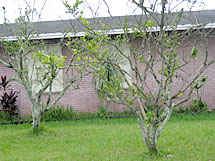
Back yard citrus trees with HLB in Florida

First some background on HLB, then clean citrus tree sources, with more resources on identification and reporting at the end:
Huanglongbing (HLB), also known as ‘Citrus Greening’ and ‘Yellow Dragon’, originated in Asia, with various strains spread throughout the world. It is a vascular disease fatal to citrus trees, which is caused by a difficult bacteria to culture (Candidatus Liberibacter asiaticus), and is associated with it’s vector: the Asian Citrus Psyllid (ACP). HLB was first discovered in the U. S. in 2005 in Florida, were it has devastated thousands of acres of commercial citrus orchards, and backyard trees. Infected trees may show no symptoms for years while still being a source of infection for other trees. Once symptoms show (see below) the tree may have only three to five years to live. HLB is now found in Florida, Louisiana, Georgia, South Carolina, and now recently in California- found in only one tree near Los Angeles. This infection has been traced back to a casual graft of infected citrus scion smuggled in from Asia, traded by backyard growers.
The Asian Citrus Psyllid (ACP), Diaphorina citri, is the only known vector for HLB (besides humans), and has been found in eight Southern and Western states. The United States Dept. of Agriculture (USDA), Animal and Plant Health Inspection Service (APHIS) regulates the movement of plants from infected states, and the California Dept of Food and Agriculture (CDFA) regulates the movement of plants from infected counties within the state. ACP is well established in Southern California’s quarantined areas, also being hosted by many citrus related species, so we should all be on alert.
Let’s do our best to follow the quarantine restrictions on citrus related plants from Southern California, source and propagate only certified disease free plants, rootstocks and scions, and keep vigilant for ACP and HLB on our own trees here in Northern California. See resources for what symptoms to look for, below. But first, here are some clean sources of citrus plants:
We have great local (Nor. Calif.) wholesale citrus nurseries to get clean citrus trees from:
(many local retail nurseries sell trees from these growers)
Four Winds Growers, http://www.fourwindsgrowers.com. The Dillon family has been in the business for fifty years and three generations, offering a really great selection of varieties. They are famed for originating and popularizing semi-dwarf citrus trees for back yard growers, and for discovering ‘Improved Meyers’ lemon, a virus-free clone of ‘Meyers’. They have expanded over the last few years beyond their grounds in Fremont, with additional operations in Watsonville and Winters. This year they have a new team member: the energetic and knowledgeable fruit enthusiast, Ed Lavio.
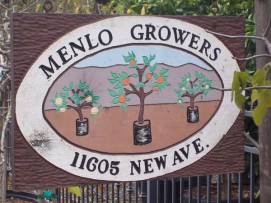
photo Anna Tzanova, Gilroy Patch
http://www.gilroypatch.com
Menlo Growers- http://menlogrowers.com/, has been located in Gilroy for thirty years, growing many types of fruit trees, including an excellent variety of citrus, including large, ‘specimen-size’ trees.
If you want to start your own trees, order rootstock in bulk from a certified nursery, like:
B & Z Nursery Inc., 1850 S. Newcomb, Porterville, CA, 93257
Phone: 559. 781.7438, Fax: 559.781.6493. No website, but I have had good experience with them.
TreeSource Citrus Nursery http://www.citrustreesource.com/, or
Willits & Newcomb- http://www.wncitrus.com/products_seedlings.php, who also offers certified budwood- http://www.wncitrus.com/products_budwood.php
The largest selection of certified citrus budwood:
University of California Riverside’s Citrus Clonal Protection Program (UCR CCPP), http://ccpp.ucr.edu/
This collection is now actually maintained in protective screenhouses at UC’s Lindcove Research and Extension Center, Exeter- where the tasting is this weekend. It is best to consolidate orders with your local California Rare Fruit Growers chapter members, and submit a larger, collective order. It will be less handling for the CCPP, and you will be able to make the minimum numbers of buds that are required, with less shipping costs. UCR also has it’s own page on ACP/HLB- http://cisr.ucr.edu/citrus_greening.html
Here are my favorite sources of information about the vector and disease- ACP/HLB:
The California Department of Food and Agriculture (CDFA) and the Citrus Research Board have the best information for California
CDFA Plant Health and Pest Prevention Services,
Pest Hotline: 1-800-491-1899
Asian Citrus Psyllid/Huanglongbing webpage,
general and detailed maps of quarantine areas, official press releases, lots and lots of info!
http://www.cdfa.ca.gov/plant/acp/
Quarantine maps for California:
http://www.cdfa.ca.gov/plant/PE/InteriorExclusion/acp_quarantine.html
ACP/HLB Multimedia Page- fact sheets, photos, posters, news articles
http://www.cdfa.ca.gov/plant/acp/media.html
For ready to print pdf’s of Flyers, ID Cards, Bookmark, and more Links from the CCPP: http://ccpp.ucr.edu/news/HLB-ACPs-ANR-Educational-7-20-07.html
Citrus Research Board is an industry group that is funding much research into combating ACP and HLB
great webpages:
http://www.californiacitrusthreat.com/
if you want ready to print pdf’s of fliers in 11 different languages, and the bookmarks also in Spanish see this page:
Save our Citrus (USDA APHIS) http://www.saveourcitrus.org/ info is not very detailed. Great graphics to catch people’s attention, and to get them the basics- like the one at the top of this post!
They do have the national info on ACP/HLB’s spread in other states, but their hottest tool is their iPhone app to identify and report ACP/HLB:
https://itunes.apple.com/app/save-our-citrus/id511305050?mt=8
There are many more technical sources of info if you just take some time with your internet search engine.
Enjoy this citrus season, and practice safe plant propagation. Watch for upcoming (clean) citrus grafting workshops.
As fellow CRFG stalwart Karl Gross signs his emails:
Stay alert!
JV
See and Taste 100 Varieties of Citrus!
Lindcove Research and Extension Center
Citrus Fruit Display and Tasting: for Homeowners
Date: December 15, 2012
Time: 9:00 AM – 12:00 PM
Contact: Anita Hunt
Sponsor: Lindcove Research & Extension Center
Location: 22963 Carson Ave, Exeter, CA 93221
Event Details
During the Citrus Fruit Display day, you can see and taste more than 100 citrus varieties that are grown at Lindcove.
Join us for this wonderful event where you can sample fruit at your leisure and participate in a sensory taste test conducted by Cooperative Extension horticulturist Dr. Mary Lu Arpaia. The Master Gardeners as well as UC Farm Advisors will be happy to answer questions from home gardeners and citrus connoisseurs.
Lindcove was featured in an episode of California Country’s 30-minute weekly television broadcast produced by the California Farm Bureau describing the people, places and lifestyles that have made California the nation’s largest food-producing state. This show illustrated the significant benefits of the Lindcove facility to the California citrus industry.
Find the video and article here: http://californiabountiful.com/features/article.aspx?arID=861
Directions: From Visalia take Highway 198 east to Mehrten Drive (Approximately 15 miles) and follow the signs to our Event. The University of California, Lindcove Research and Extension Center is located at 22963 Carson Avenue (corner of Road 228) Exeter, CA.
Pomegranate and Persimmon tasting at Wolfskill Experimental Farm, Nov. 2012
The USDA National Clonal Germplasm Repository Davis held it’s 12th pomegranate and persimmon tasting at the Wolfskill Experimental Farm near Winters, the site of their field collections. This collection of fruit nut varieties includes some 7,414 accessions, including 22 genera, and 248 taxa of 220 species, a real Noah’s Ark of perennial fruit and nut varieties for Northern California.
The tasting was held outside in the shadows of huge olive trees, amid the vast grape (Vitis spp.) collection which alone contains some 3,000 accessions. Other years, rainy November weather forced the tastings into a crowded room, so it was great to enjoy a sunny day outside, allowing over 75 participants plenty of space to sample some 18 varieties of pomegranates, and 5 kinds of persimmons.

Jeff Moersfelder discussing the diversity offered at the tasting, selected from the collection of 275 accessions of pomegranates (Punica granatum), which he manages for the USDA. Set up similar to a wine tasting, the varieties were arranged from mildest to strongest flavored. In this photo, the most tart varieties are in the foreground. Pomegranate enthusiast and grower Harvey Correia is also seen in the crowd (with the pomegranate t-shirt).
Preparations started weeks before the event, with the pomegranates being harvested at their peak of ripeness and stored, before the early fall rains could increase the chances of the fruit splitting in the field. On the Thursday before the Saturday tasting, the processing of the fruit began. Jeff documented the fruits from each variety, from each year’s harvest. This data is made available through the USDA ARS NCGR Davis pomegranate webpage: http://www.ars.usda.gov/Main/docs.htm?docid=12170
The removal of the arils (the juicy flesh around the seeds) from the bitter skins of the fruits is a lot of work. With eighteen varieties each requiring about 2 kilos of clean arils each for the tasting, there was 50 -75 pounds of arils to clean. This took perhaps 30+ hours of labor. Along with USDA staff and volunteers from the UCCE Sacramento Master Gardeners, I spent about 4 hours volunteering toward the effort, and enjoyed sampling the culled, off types! I wore my pome juice splattered clothing proudly. We carefully set aside the rind of some varieties for an interesting research project studying the anthelmintic (expelling parasitic worms) effects on goats!
The best way to clean the fruit is by carefully cutting it in half by just cutting through the outer skin, so you can pull it apart. Then it is scored further along the outside of the inner membrane divisions, and pulled apart into yet smaller sections. This avoids damaging the little arils and losing their juice. The resulting segments are then slapped vigorously on the thick rind side with a heavy spatula over a bowl of water, so the seeds jump out of their tight little seats into the water, sinking to the bottom. The juice from the few damaged arils is washed away by the water, and the bitter white bits of membrane float to the surface, where they are easily removed. The free arils are then rinsed well, spun dry in a salad spinner, and bagged up into gallon zip-loc plastic bags (1-2 gallons per each variety) for cold storage until the tasting.

The table of varieties being set up before the tasting, with the pale, mild ones in the foreground
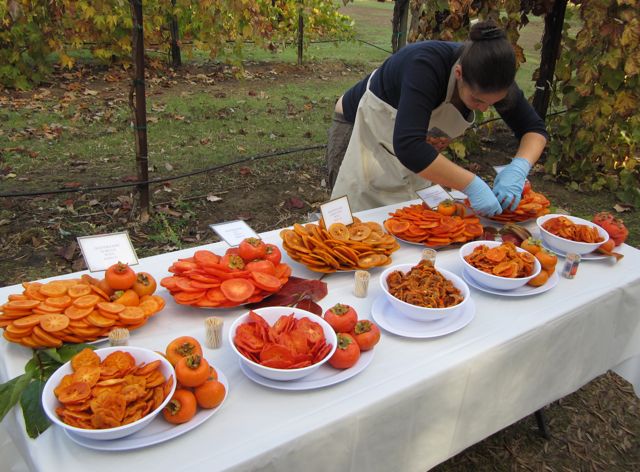
Jenny Smith, who manages the Diospyros collection, artistically arranging her persimmon varieties for tasting, both fresh and dried, which she chose from some 139 accessions of Kaki.
See the Diospyros kaki page here: http://www.ars.usda.gov/Main/docs.htm?docid=12138
These selections of Japanese persimmon, or kaki, were not the astringent types that need to be totally soft ripe to eat. They were all edible when hard, known botanically as Pollination Constant Non-Astringent (PCNA). But there was one selection that was Pollination Variant Non Astringent (PVNA) type- that is astringent when not pollinated, becoming non-astringent when pollinated, and seeded. (My permaculture friend Eric Ohlsen didn’t know about this phenomenon, so he was disappointed when his newly fruiting ‘Coffee Cake’ persimmon was suprisingly astringent, until I told him it was only because his pollen source- a young ‘Fuyu’ tree nearby- had not flowered yet- mystery solved!)

Pollinated, this PVNA variety is non-astringent and edible when still firm ripe and develops seeds, and the characteristic cinnamon speckled coloration of the inner flesh, also known as a ‘chocolate persimmon’, or ‘Maru’ type. Un-pollinated, this would not have any of the brown coloration, no seeds, and taste astringent when firm.
After a formal greeting and introductions by head researcher John Preece, Jeff and Jenny talked about the selections they made for the tasting, and we all took our time tasting, chatting and comparing notes. For me, it was hard to pick a favorite, they all had their own appeal! I will post the lists of the cultivars which were sampled, soon.
Knowing that not everyone would be able to attend the event, I made arrangements with chestnut farmer and pomegranate collector Harvey Correia to purchase a box of 20 pounds of pomegranates of mixed varieties. This would allow our Golden Gate CRFG chapter members to taste the diversity at our upcoming meeting. I asked him to include more varieties on the light and bland side, as these are easier to ripen in cool, coastal areas where many of our chapter members live. Harvey also had many varieties of pomegranate plants for sale at the Wolfskill tasting. We hope that Harvey will offer plants for sale at our upcoming CRFG scion exchanges. You can visit Harvey’s pomegranate website here: http://www.purelypoms.com/ , and the pomegrante internet forum he founded and moderates: http://tech.groups.yahoo.com/group/PomWorldwide/.
The vast collection of fruit and nut varieties maintained by the USDA is made available for research and educational purposes. From their website:
“Due to the intensive effort and resources required to ensure availability of germplasm for this purpose, we are unable to distribute it for home gardening or other purposes that can utilize readily available commercial cultivars.”
If you are interested in those varieties which are not available through local retail nursery, or mail order sources, I would encourage you to contact your local chapter of the California Rare Fruit Growers to request such material from the USDA. In this way, many small orders are consolidated into larger orders that reduce effort and costs for the USDA, stretching our federal tax dollars. And you just might meet some interesting local fruit enthusiasts.
Thanks to the California Rare Fruit Growers, UCCE Sacramento Master Gardeners, USDA ARS NCGR Davis, the many volunteers, and all the tasting participants.
-JV
‘Edible Forest Gardens’ workshop with Eric Toensmeier, hosted by Brock Dolman and OAEC.
Though I was not able to attend all of the workshop held at the Occidental Arts and Ecology Center http://www.oaec.org/, I nonetheless became even more inspired, and grounded in the practical applications of ‘Edible Forest Gardens’, with the best on the subject: Mr. Eric Toensmeier, author of ‘Perennial Vegetables’, and co-author of ‘Edible Forest Gardens, Vol I & II’. Hosted by the resident water man, wildlife ecologist and permaculture player Brock Dolman, it was a combination I could not resist.
The word went out that the workshop was at capacity for registrations, but there would also be a public presentation at the Sebastopol Grange- one of those new generation “organic granges”. With a farmers market in the main room, 75-100 of us and squeezed into an smaller adjacent room to see Eric’s presentation. It was quite a polyculture of local permaculture enthusiasts.
Here is some of what I gleaned from the workshop:
With a core of Permaculture Design, this workshop was based on pattern recognition, and application. This was exemplified by the numerous case studies, ecosystem analysis, and species exploration (fellow ‘plant nerds’ were satisfied), all brought together through the Design Process. Eric walked us through is own development, along with his buddy Jonathan Bates, of a barren and degraded suburban backyard at their home in Massachusetts. The steps he promoted are based in good ecology and human development, as Eric is skilled with both plant and people symbiosis:
- Setting goals
- base mapping site,
- analyze and assess site,
- using a ‘guild build’ to develop a species palette,
- find ecological analogs,
- develop a design concept,
- schematic design
- a detailed design,
- specific polycultures.
This process was used in the case study of the transformation of Eric and Jonathan’s own backyard from a bare lot, to a fantastic multipurpose, majorly edible “Agro-Geekosystem”. After sharing his mistakes (or learning experiences) and successes, the evolution of the forest seemed miraculous.
Revising some more lofty beginning goals, later they arrived on the core goals of:
- Growing what we like to eat,
- that grows well for us
- in functioning poly cultures.
Also, he and his ‘plant geek’ buddy found their female partners in the process! (one of their original goals)
With this case study, Eric basically gave us a preview of his new book:
Paradise Lot, due to be released by Chelsea Green Press in Jan 2013.
Paradise Lot
Two Plant Geeks, One-Tenth of an Acre, and the Making of an Edible Garden Oasis in the City
by Eric Toensmeier
How we did it and the challenges along the way
ISBN: 9781603583992
http://www.chelseagreen.com/bookstore/item/paradise_lot:paperback
We then enjoyed a walk about, a parapatetic pursuit of productive perennial polycultures (catching Dolman’s wordplay fever). Touring the Occidental Arts and Ecology Center grounds is always a botanical delight, as we learned about the ancient pear tree established some 100 years by pioneers, the plantings by Robert Kourik and others during the ‘Farallones Institute Rural Center’ era of some 30 years ago, and the more recent plantings tended to by the current OAEC staff, mostly led by ‘Dougo’ Gosling, and Brock.

Brock shows us the swale planting of ethnobotanical species from last year’s edible forest garden workshop
I missed parts of the workshop when I took a tour of the Permaculture Center in South Sebastopol, with founder Eric Ohlsen, and attending the pomegranate and persimmon tasting at the Wolfskill Experimental Orchard (see my post on the tasting soon)
I re-joined the workshop on the field trip day, again visiting with Eric Ohlsen (owner, principle and senior designer) of the integrated design and install business ‘Permaculture Artisans’ http://www.permacultureartisans.com, at his residence aka ‘Permaculture Neighborhood Center’
Another example of a lush productive food forest flourishing where was once a barren paved back yard (they removed 45 yards of concrete and asphalt in the process!) Here are some images from Eric’s website that show the transformation:
http://www.permacultureartisans.com/Gallery/permacultureNeighborhood/permacultureNeighborhood.html
Tearing down fences with his neighbor, who happens to be a friend since childhood, the combined back yards infiltrate about 400,000 gallons of run off, mostly from another neighbor’s paved lot, through a series of contour infiltration swales and overflow basins, while keeping some areas well drained for access with rock filled trenches. A densely planted pond featured diverse plantings providing habitat for many beneficial insects, amphibians, and much more, all centered around a melodious waterfall which dilutes the buzz of the nearby Bodega Hwy.
After seeing the abundance of a such a well designed backyard productive perennial polyculture, including timber trees (such as paulonia), nitrogen fixing trees and shrubs (such as tagasaste and Eleagnus spp.), fences of peach trees, selfsown annuals (liken daikon and arugula), chickens, roofwater catchment, cob oven, solar powered lights, and much, much more, we bid farewell to Eric and his family, and continued our field trip.
Walking just a block away, we traveled back in history more than 100 years to explore the historic Gold Ridge Farm, a.k.a. the Luther Burbank Experimental Farm, founded in 1885, which is now a public park. http://www.wschsgrf.org/luther-burbank-gold-ridge-experiment-farm
I will do another blog post on this legacy of the ‘Plant Wizard of Santa Rosa.
The final day of the workshop climaxed with the participants working in groups on a “Guild Build” exercise, and a hands-on planting, diversifying an existing orchard situated between annual garden beds and the wild mesic forest along a path to Brock’s home.
Dozens of new species of plants were introduced which have never been grown at OAEC (is that possible? they have so many plants in their collection!) We all had a great experience: from theory and design, to selection and implementation, getting things in the ground.
This weekend reinforced what I already knew: both plants and people do benefit from growing together. Thank you Eric, Brock and all the participants.
——-
Eric’s website http://www.perennialsolutions.org/ has a wealth of resources.
I want to follow up on all the Plant & Seed Sources found here:
http://www.perennialsolutions.org/perennial-plant-seed-sources-catalogs-stores-permaculture-varieties-hardy-hybrids-organic-gardening.html
Keep it juicy,
JV
Report on a full weekend of fruit tastings and more.
Last week I participated in various Bay Area events, so here is my report:
On the heels of the Northern California Permaculture Convergence, held at the MA Center out in Crow Canyon Rd. off Castro Valley, Geoff Lawton led four days of advanced workshops. I missed the first few days of watershed design, earthworks, and reforestation, but decided I could not miss Lawton talking about food forests at one of my favorite broadscale permaculture oriented orchards in the Bay Area. Michael Flynn, of Common Vision Fruit Tree Tour fame, has led this project with support of the MA Center’s “Green Friends’. Over the four yeas since the project began, Michael has invited me to collaborate with him on the project, and has repeatedly brought the best of the best to share their expertise in consulting on the project in conjunction with many educational workshops: Dr. Eileen Ingham on the ‘soil food web’, Michael Phillips on the ‘holistic orchard’, Darren Doherty on water retaining earthworks of the ‘Keyline System. and Geoff Lawton. Assuming the leadership of the Permaculture instiute of Australia from Bill Mollison, Lawton has put the Permaculture Research Institute International on the map with a huge web presence, and nurmerous videos, some describing establishing a food forest, and examples of an 800 year old food forest in Vietnam, and aother 3000 years old in Morocco.
The recent hot weather had been moderated by a few days of misty precipitation, so the hillsides were still brown with just the beginnings of a return to the green season. About fifty people participated in the Food Forest day I attended. With the invitation from Jay Ma of Living Mandala, and Michael Flynn, I joined Geoff to give the discussions a local experience perspective. Geoff began with his food forest examples from around the world, and introduced the concept of ‘analog climates’, which looks to similar climates from around the world for successful and productive plant species, management strategies, vernacular architechture, and other human cultural adaptations. For us that would be latitude 38 degrees N or S, along the west coasts of the oceans: Portugal, Chile, South Africa and Australia all have parallels to us here in the SF Bay Area.
Establishment strategies were discussed, with stacking, overplanting, and quick ground cover establishment (all creating shaded ground) being themes that are so important in the subtropical, summer rain climate Lawton comes from in Australia. In contrast, Lawton later noted that our dry summers hold back the competitive growth found in wet warm climes. After lunch we made it up to the orchard site, making observations of the multilayered fruit orchard of mostly apples with some other species such as persimmons, plums and pears. To increase diversity and sustainability, the fruit trees are interplanted with native nitrogen fixing shrubs (Ceanothis spp.) and comfrey which were being cut for building soil with mulch, along with mediterranean herbs for beneficial habitat like lavender and various sage species. We brainstormed for additional ground cover species, as the bind weed was beginning to establish itself.
Lastly, we visited the site of a new spring fed pond being excavated by our favorite equipment operator, the skilled and super nice guy Rusty Davis. This additional water will allow for future expansion of the orchard to achieve the goal of planting 1,000 fruit trees, which was requested by the spiritual leader of the MA Center.
Tastings galore! First I sampled some drylands fruit
The weekend continued with various tastings in the Bay Area, too many to attend, forcing me to choose. First I ventured out to suburban Walnut Creek, to the Ruth Bancroft Gardens, a fantastic collection of drought hardy trees, agaves, aloes, cactus and other succulents. As we toured the spectacular gardens with expert docents, we tasted half a dozen varieties of tunas, the fruits of prickly pear catus (Opuntia spp), two species of jelly palm (Butia spp), dragon fruit, feijoa or pinapple guava (quality of fruit approved by Ken Litchfield who was also there), pomegranate (Puncia sp), and strawberry tree (Arbutus sp). Ruth Bancroft is now 102, and still lives in her home on the property.
Apples near Santa Cruz-
I then drove out to Santa Cruz to help out with the apple tasting the Monterey Chapter CRFG was offering at the Wilder Ranch State Park Harvest Festival. Amid pumpkin patches, the sound of the blacksmith’s hammer, horse drawn cultivation, old time farm machines, and costumed participants, the CRFG had over sixty varieties to sample all grown locally in the Santa Cruz area. As with any tasting you may attend, you are tasting some fruit that is past it’s prime, others that are not ready yet, and hopefully many that are right on! This can vary from year to year, depending on the weather, and give different taste test winners on the same date. So last year’s winner ‘Fukunishiki’, may have still rated in the top ten, but this year’s top picks were some of the typically more tart varieties like ‘Tydeman’s Late Orange’, and the Etter bred pink fleshed ‘Pink Parfait’ and ‘Grenadine’ that seemed to be the favorites, perhaps benefitting from the late Sept heat wave. Other top rated apples were: Brushy Mountain Limbertwig, Allen’s Everlasting, Karmijn de Sonnaville, Katherine, all strongly flavored apples.
Each of the 200+ tasting participants were given four sparkly star stickers to award to their favorite varieties listed on a large poster board- so the results we immediately available for all to see.
Bioneers seed swap-
After sharing good food and company, and cleaning up with the Monterey chapter folks, I made my way back to Bioneers that was also that weekend. In addition to dozens of inspirational speakers, that evening there was a seed swap sponsored by various Bay Area seed heads.
More apples in the shadow of Luther Burbank-
Sunday the Redwood Empire Chapter CRFG had their apple and pear tasting at the Burbank Goldridge Experimental Farm in Sepastopol, one of my favorite gardens to visit. Fifty apples and half a dozen pears were blind taste tested, only identified by a number. The results were sent out a couple of days later with the top five rankings given to Braeburn, Wickson, Liberty, Arlet, and Newton Pippin. Interestingly, longtime favorites ranked at the very bottom this time: Fuji, Mutsu, Elstar, and Tydeman’s Late Orange (yes, the one that was on top in Santa Cruz!)
Preparing for our next Scion Exchange-
Later on Sunday, I met with our Golden Gate CRFG Scion Exchange planning group, working out the details of our biggest event of the year, the Jan 19, 2013 fruit tree propagation extravaganza will be held at the Ed Roberts Campus adjacent to the Ashby BART station.
That weekend, I totally missed the Grape tasting with Richard Jeske in Mendicino, plant sales at various nurseries, Fort Ross Harvest Festival celebrating their 200th anniversary, the Food Crops of the Americas exhibit at the UC Berkeley Botanical Garden, the Alameda Master Gardeners Fall Seminar, and several other events.
Northern California Food Forests featured in future Lawton video-
Monday I tagged along as Geoff Lawton visited Oakland’s Merritt College Permaculture Food Forest Hillside, to be featured in a video on Food Forests in various climates. Christopher Shein will be featured in the video, as he initiated full Permaculture Design Certificate Course courses at the community college, and is one of the coordinators of the Food Forest (along with Anders Vistrand and Ken Litchfield, among others). Later in the day they visited the Petaluma Seed Bank to load up on heirloom vegetable seeds to bring back to Geoff and his wife Nadia’s projects in Jordan, where she is from (see ‘Greening the Desert’).
Oh well, I had enough fun that weekend, expanding my tasting experiences, while continuing friendships and establishing new connections in the fruitful world we love to live in.
-JV
Designing Edible Forest Gardens evening talk with Eric Toensmeier
The Occidental Arts and Ecology Center’s Permaculture Program Presents an evening lecture:
Designing Edible Forest Gardens with Eric Toensmeier
Come hear a fascinating and educational lecture by this internationally renowned author and Permaculturally based Edible Forest designer & educator! See the book titles below!! Also – Eric is just an amazingly knowledgeable plant geek concerning uber-multifunctional-edible plant systems!!
Where: Sebastopol Grange Hall on Hwy 12
When: Thursday Nov. 1st from 7pm to 8:30pm
Why– Because Edible forest gardens mimic the structures and functions of natural ecosystems while producing healthy food and other products, with an emphasis on low-maintenance perennial crops. Design and plant selection help provide fertility, control of weeds and pests, and more. Eric will emphasize the design and maintenance of temperate climate Permaculture edible forest gardens.
Sliding scale $5 to $10 at the door. No one turned away for lack of funds
Please forward around!!! – Lets fill the room since Eric is flying here all the way from the North East to be with us!
Contact Brock Dolman Brock@oaec.org
Report upcoming on all the tastings and events I attended this weekend . . .
Gathering my wits after a whirlwind weekend of food forestry at the MA Center’s orchards with renowned permaculturist Geoff Lawton, a cactus and palmfruit tasting at the Ruth Bancroft Gardens in Walnut Creek (Ruth is 102 and lives on site there!), 2 apple tastings: one of 62 varieties at the Monterey Chapter CRFG tasting at the Wilder Ranch in Santa Cruz, and another of 50 or so varieties of apples and pears held at the Burbank Goldridge Experimental Farm in Sabastopol, courtesy of the Redwood Empire Chapter CRFG.
Oh, yeah- I also made it to the huge seed swap at the Bioneers too!
I will post more details on those experiences as soon as I compile my notes.
Digging Deeper: Revitalizing the Urban Garden, a Bay Area Gardening Seminar this weekend
Yet another great event this weekend:
the ACMG 10th Annual Fall Seminar on Bay Area Gardening:
Digging Deeper: Revitalizing the Urban Garden
Saturday, October 20, 2012 from 8:30am to 3pm
(Registration begins August 31)
at the Garden Center at Lake Merritt,
666 Bellevue Avenue, Oakland
Cost for all day seminar: $45
Lunch optional (provided by The Mixing Bowl, Oakland): $10.50 (Must be ordered by Oct 13th)
Alameda County Master Gardeners 10th Annual Bay Area Gardening Seminar 2012 promises a harvest of wisdom on design, maintenance and gardener well-being! In the twelve topics presented by outstanding experts, urban gardeners can explore the abundant possibilities in a residential city garden with Leslie Bennett & Stefani Bittner’s beautiful edible gardens, Fred Bove and his SF rooftop container garden and Phil Van Soelen’s native plants. Greywater guerilla Christina Bertea offers waterwise suggestions, SF Chronicle columnist Pam Peirce addresses pest management and Jennifer Radtke gives all the buzz about urban honeybees. Blacksmith Grant Marcoux maintains the edges of our tools, Physical Therapist Gail Durkin shows us sensible use of our bodies in garden labors, and University of Pacific Professor Mark Brunell identifies common Bay area plants and what their Latin names tell us. Finally the Master Food Preservers of El Dorado County provide kitchen tips on dehydrating, condiments and all things tomato.
more info here:
http://acmg.ucdavis.edu/Fall_Seminar/
Many exciting events this coming weekend Oct 20, 21
I will be posting here more regularly now, so following this blog should be much more interesting!
Taste apples in Santa Cruz or Sebastopol, or grapes in Willits, or cactus and palm fruits in Walnut Creek, or heirloom fruit from a 198 year old orchard at Ft Ross, next weekend.
And BIONEERS in San Rafael!
Cannot do them all. . . it is so hard to choose! Hope to see you at one of them-
Apple Tasting with the California Rare Fruit Growers,
WILDER RANCH STATE PARK
Harvest Festival and Draft Horse Day
Saturday, October 20
11:00am to 4:00pm
Located two miles north of Santa Cruz, on Highway 1 (831) 426-0505
Celebrate harvest time the old-fashioned way at Wilder Ranch State Park on Saturday, October 20, from 11:00 a.m. to 4:00 p.m. Choose and decorate a pumpkin from the pumpkin patch, take a draft horse wagon ride, see antique tractors and living history demonstrations, try your hand at some old-time harvest activities, listen to live bluegrass and western music, learn to square dance, play the snap-apple game, make corn husk dolls and other crafts, taste hand-cranked pumpkin ice cream, apple and pumpkin pie. Apple tasting of dozens of varieties will be available for $5 per person, courtesy of the California Rare Fruit Growers. Food concessionaire available or pack a picnic lunch. Admission to the event is free; parking is $10.00 per car.
http://www.parks.ca.gov/?page_id=26413
————————————
Grape tasting, October 20, 12-5pm, Willits
Chapter member Richard Jeske, who grows 150 varieties of grapes at his home in Willits, will host a grape tasting there on October 20 from noon to 5. About 25 varieties of grapes will be available for tasting, along with about 15 varieties of vines for sale. Participants are welcome to bring their own grapes for tasting, also.
For information and directions, call or e-mail Richard at (707) 459-5926 or easthill@instawave.net.
————————————
Founded 1812, join in on the Bicentennial Celebration-
Fort Ross Harvest Festival, October 20, 10-430, Near Jenner
Susan Rudy, the caretaker of the Fort Ross Orchard (founded 1814), spoke at the Festival of Fruit last month about this unique orchard and its evolution through the history of settlement on the north coast. As part of the Fort Ross bicentennial, the state park will hold a Harvest Festival on October 20, from 10:00 to 4:30. During the morning, participants will help gather fruit from the orchard, and in the afternoon there will be a tour of the newly reconstructed windmill, and juicing, baking, crafts, and a musical performance of Russian songs and dances. There is an entrance fee of $12.00 per car ($11.00 for seniors.)
———————————-
Fruit Tasting Tour
Ruth Bancroft Gardens
1500 Bancroft Road. Walnut Creek, CA
Saturday, October 20: 10-11:30am
Fruit Tasting Tour
Fall is a great time to sample! The Garden has an abundance of fruit-producing plants, which we will taste on this tour, including palm fruit, dragon fruit, and other unique cactus fruits.
Become a prickly pear fruit connoisseur while comparing several of the varieties we grow at The Ruth Bancroft Garden. All ages are welcome to attend.
Saturday, October 20: 10-11:30am
Due to the nature of this event, advanced registration will be required to attend.
Garden Admission plus $8: $18 general admission; $15 Seniors or students, $8 for Garden Members or children under the age of 12
General Admission tickets may be purchased online here or by calling the Office.
RBG Members, Students, and Seniors, please call the Office for your tickets.
(925) 944-9352
http://www.ruthbancroftgarden.org/rbgarden/pages/themetours.html#FruitTasting
———————————
Redwood Empire Chapter California Rare Fruit Grower’s
Annual Apple Tasting
October 21, 1:00 to about 4:00
Luther Burbank Gold Ridge Farm, 7781 Bodega Avenue, Sebastopol
We’ll sample and rate about 40 different varieties of apples and also some pears. Parking will be at St. Stephen’s Episcopal Church, at 500 Robinson Road. As always, volunteers are needed and welcome, to cut up fruit beforehand and during the event.
———————————
The Bioneers Conference: Connecting People With Solutions and Each Other
October 19-21, 2012
Marin Center, San Rafael, CA
http://conference.bioneersgroup.com/
“Occasionally a conference can, by the strength of its vision, create a whole new context within which to understand an issue. It can also build a network among people in related but separate fields of activity. The Bioneers Conference achieves all this, and more—being there changes the way one views the landscape of the environmental movement. Bioneers is central to the re-imagination of what it means to be human.”
– Paul Hawken, author and social entrepreneur
The acclaimed annual National Bioneers Conference is a pre-eminent leading-edge knowledge forum where brilliant social and scientific innovators illuminate breakthrough solutions for restoring people and planet. As a network of networks, Bioneers connects people with solutions and each other in an inspiring celebration of the applied genius of nature and human ingenuity.
The 23rd annual conference will feature well-known leaders such as Paul Hawken as well as “the greatest people you’ve never heard of. It animates a kaleidoscope of interconnected topics, highlighting:
¨ Climate Change Solutions & Action
¨ Protecting the Amazon Rainforest
¨ Building Resilient Communities
¨ Advancing Women’s Leadership
¨ Feminomics
¨ Creating Justice
¨ Reinventing Eco-nomics
¨ Restoring Ecological, Local and Just Food and Farming Systems
¨ Plus: Ending the War on Drugs, Faith-based Action, Cosmos and Psyche
¨ And the Native-directed Indigenous Forum of Indigenous Wisdom

